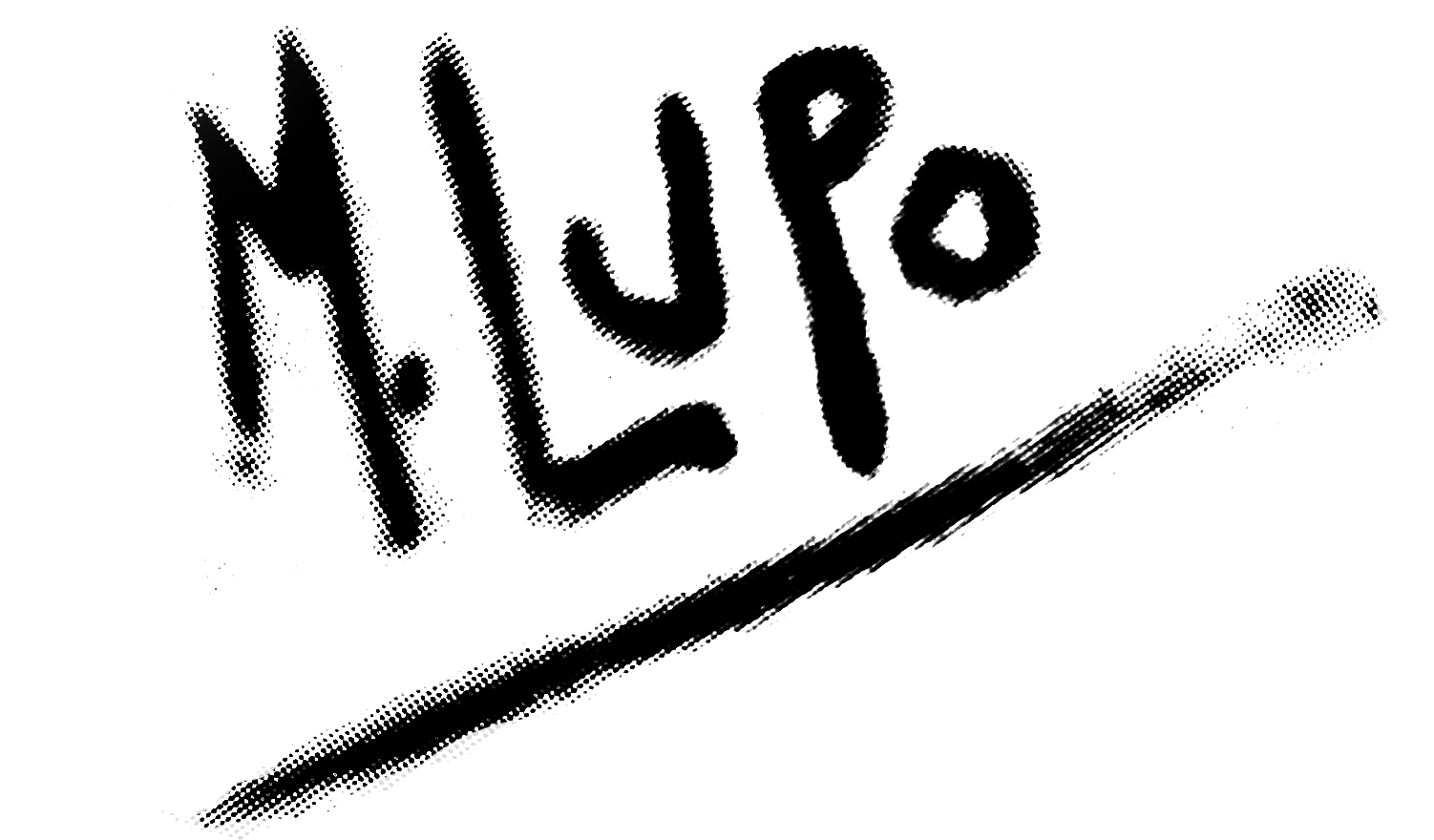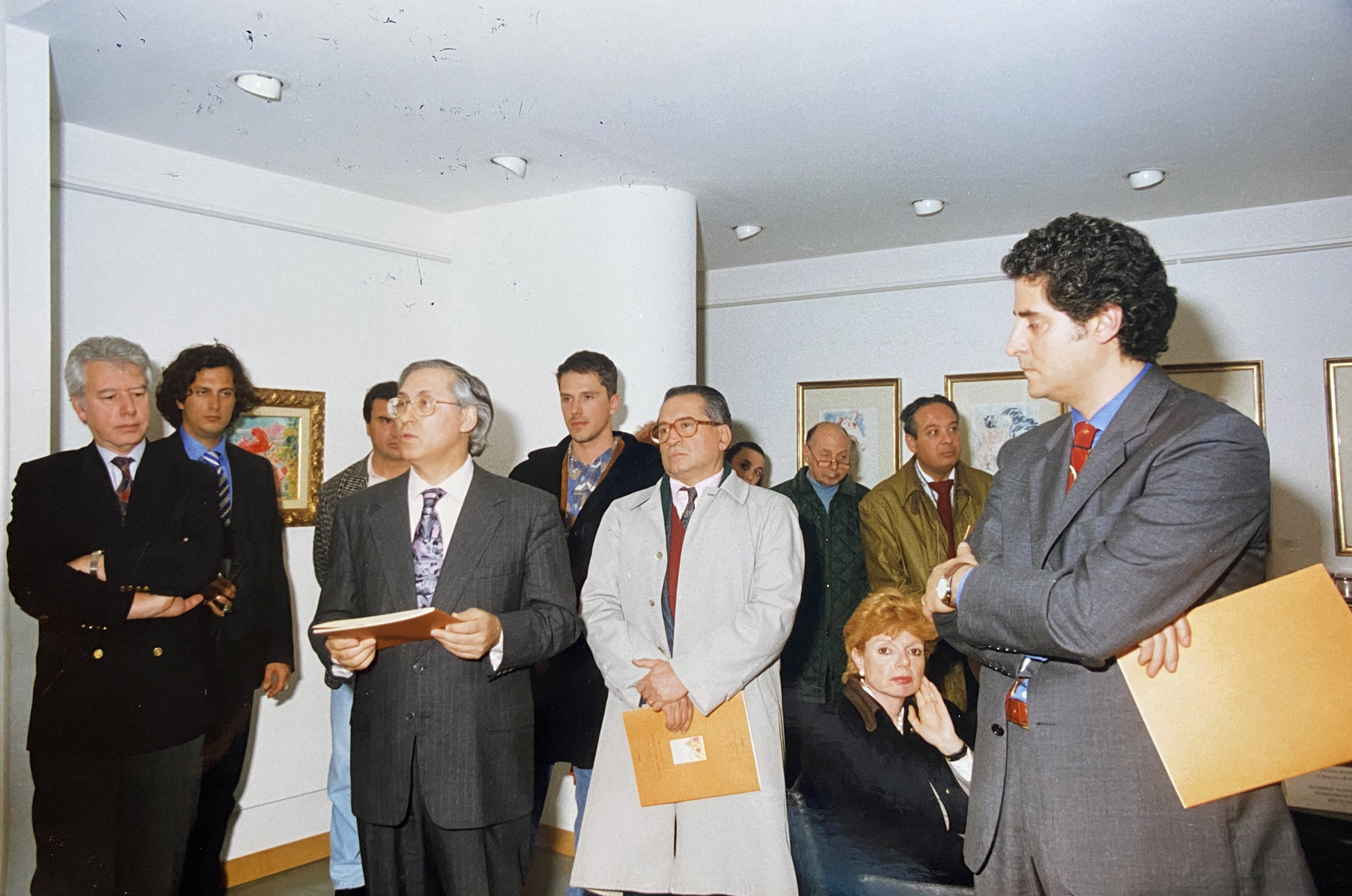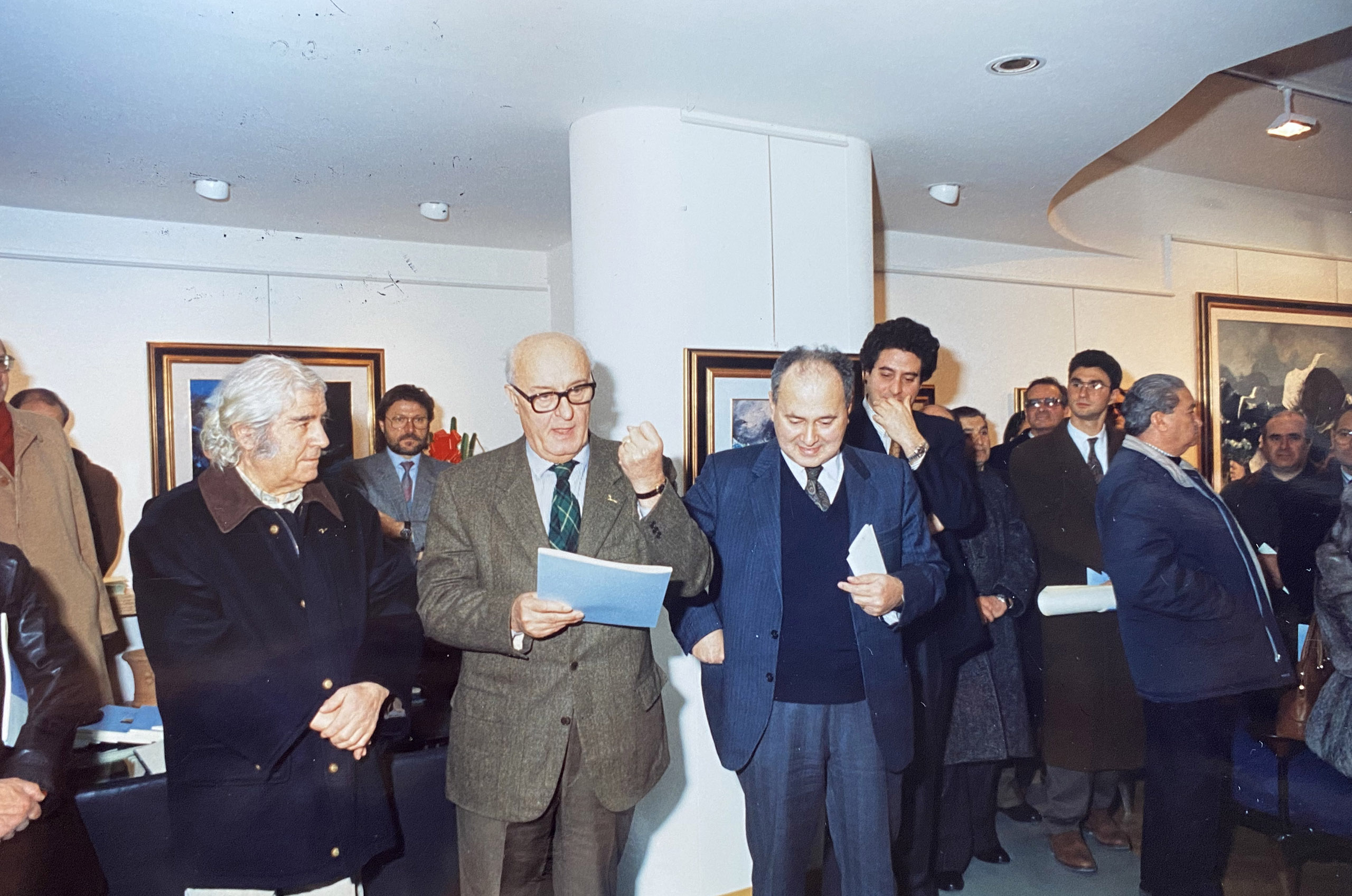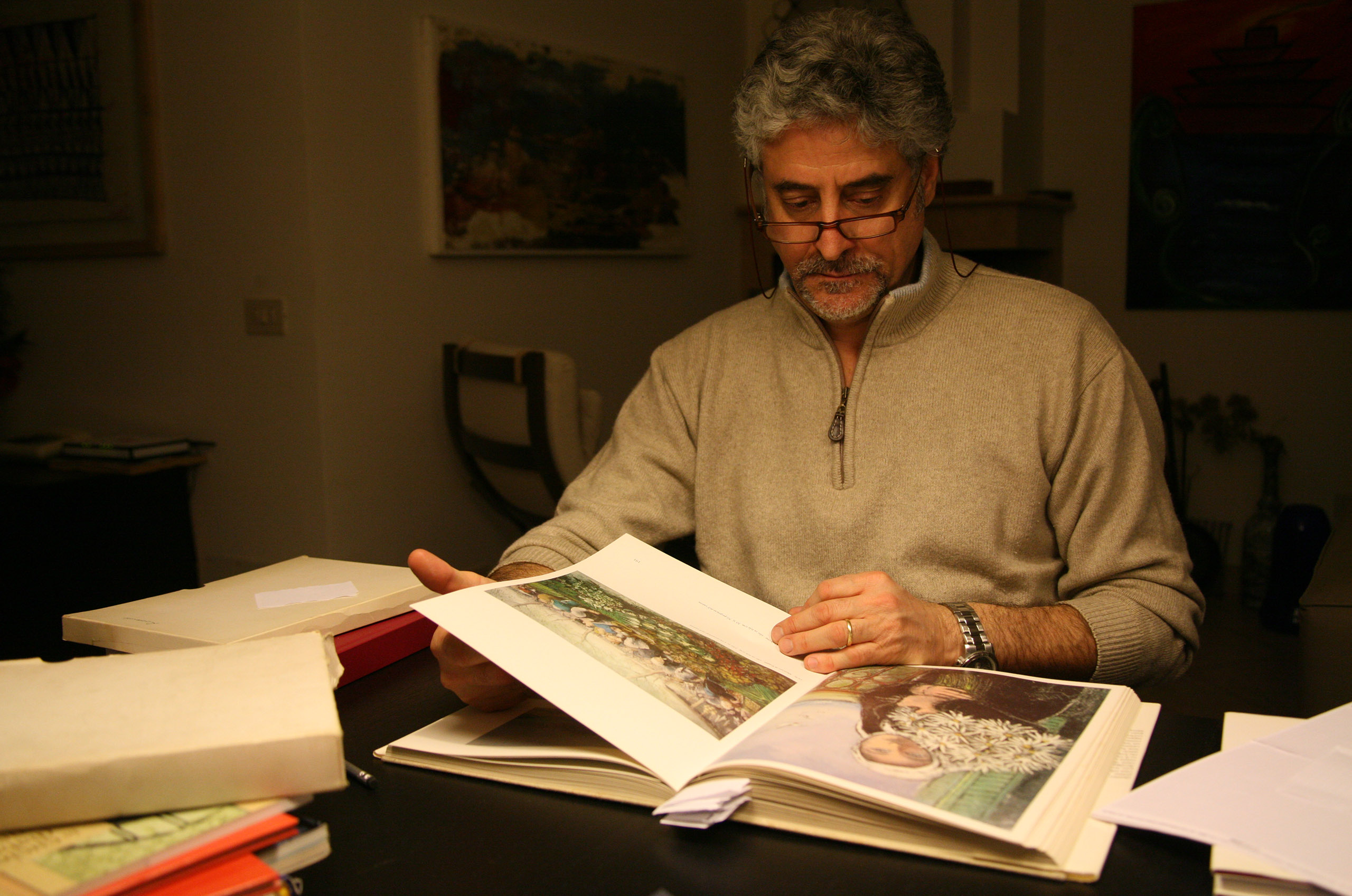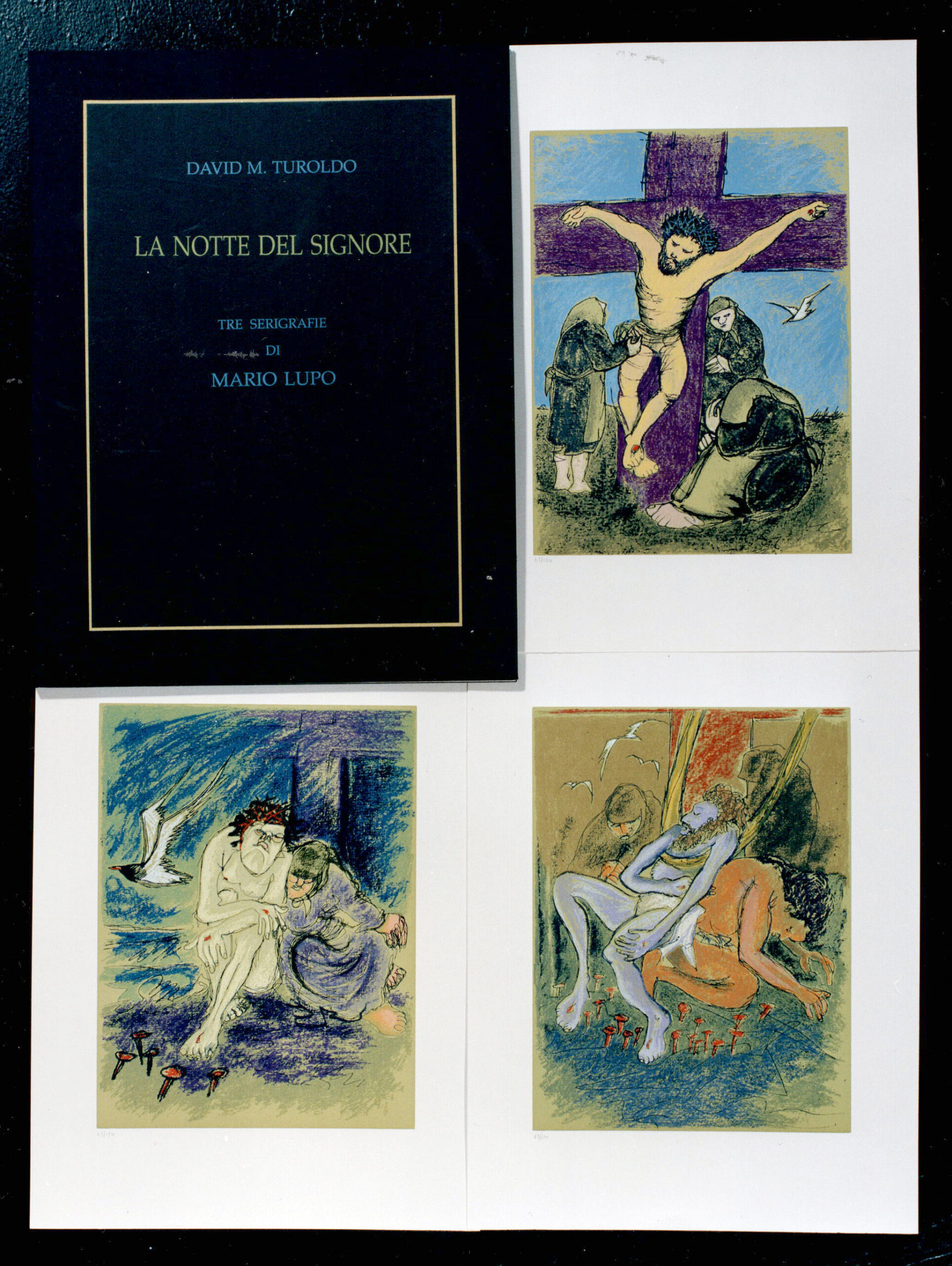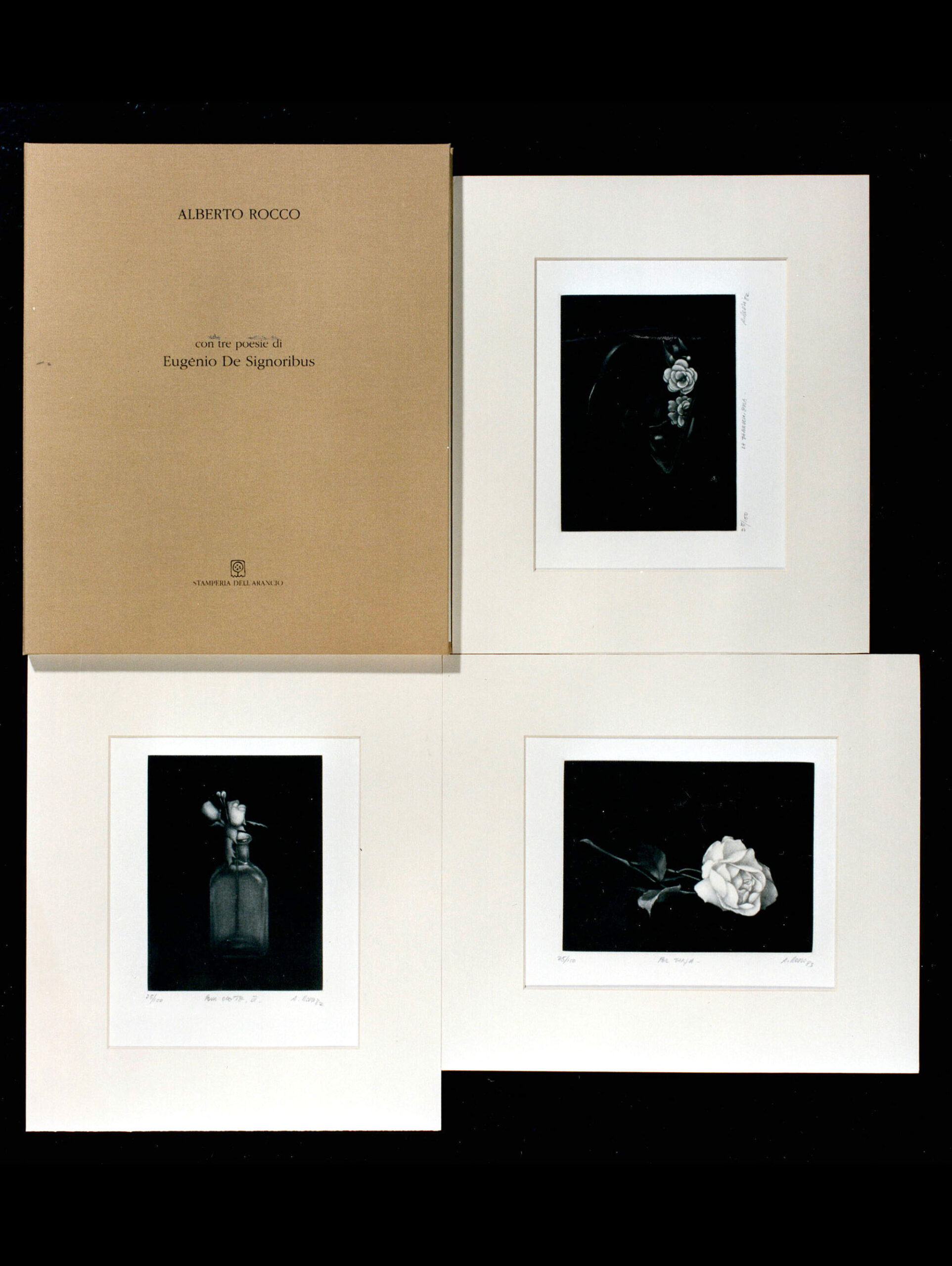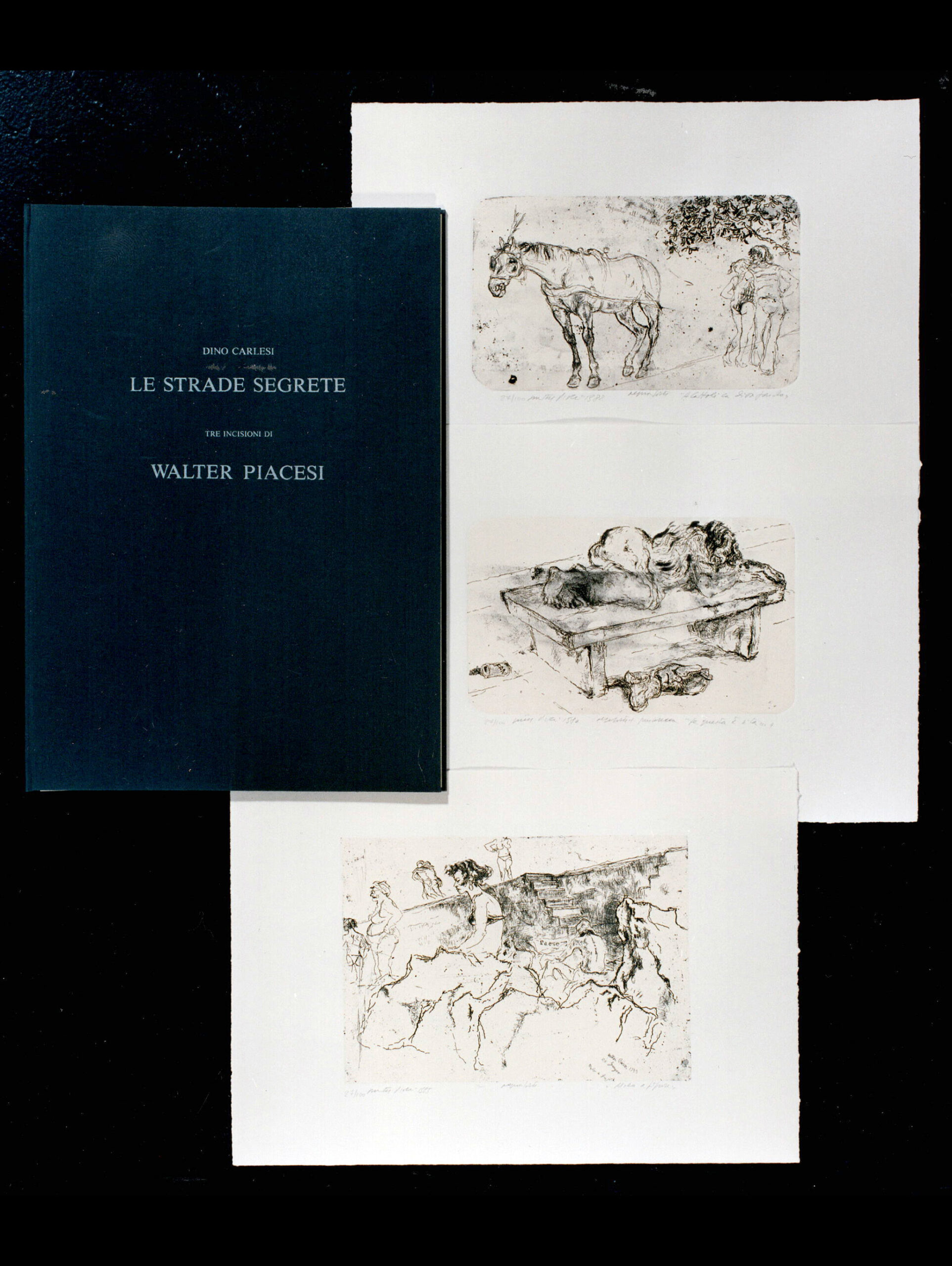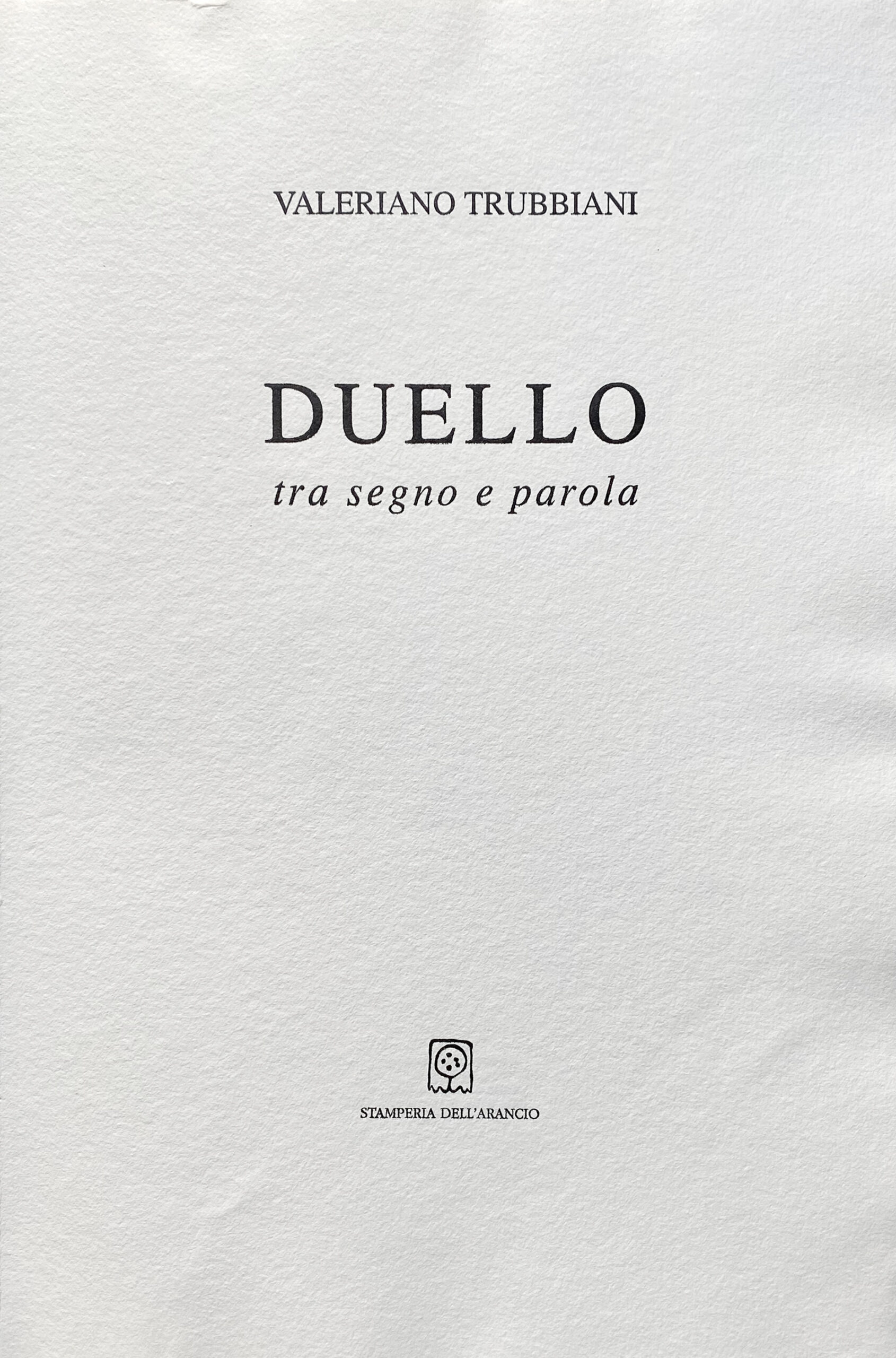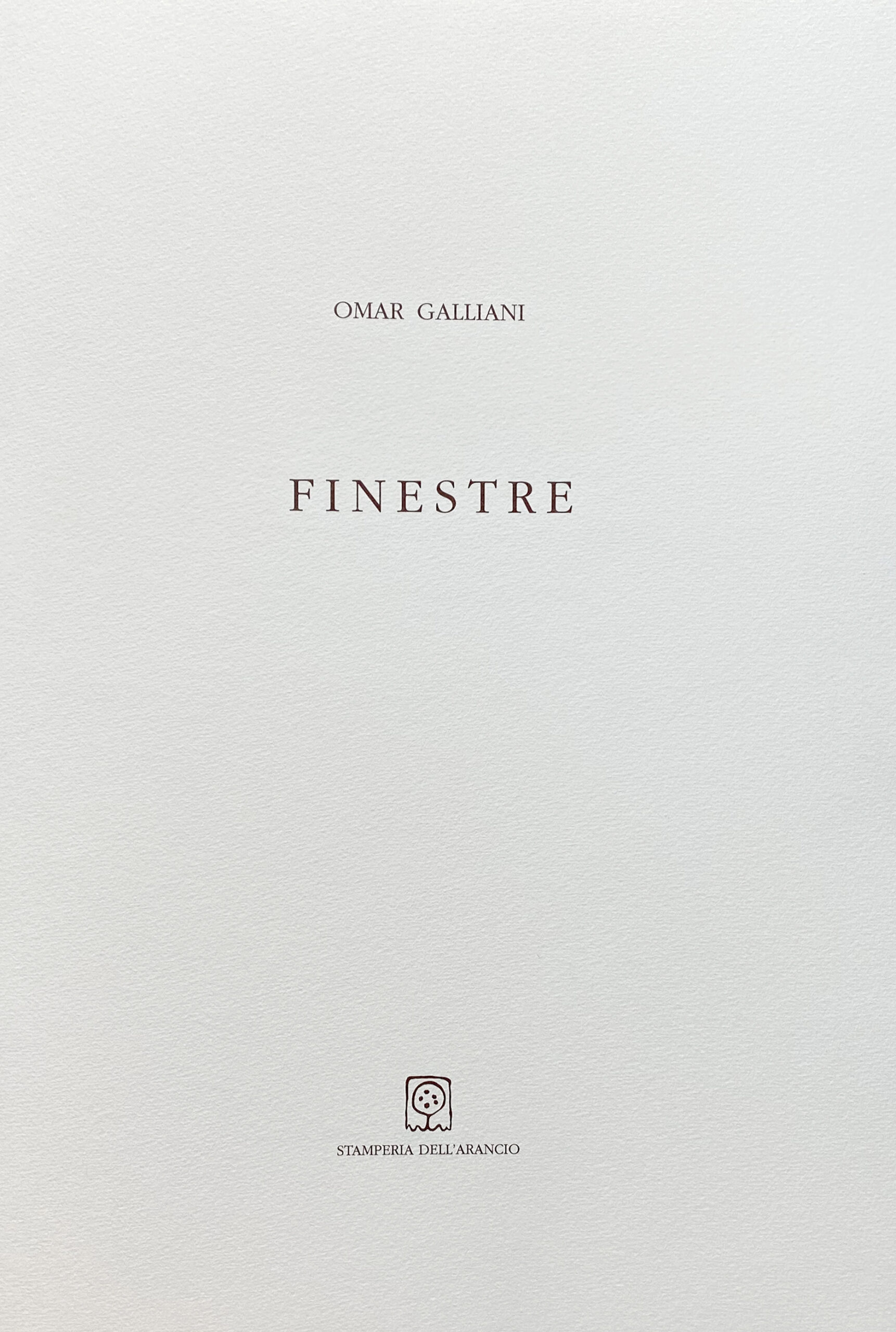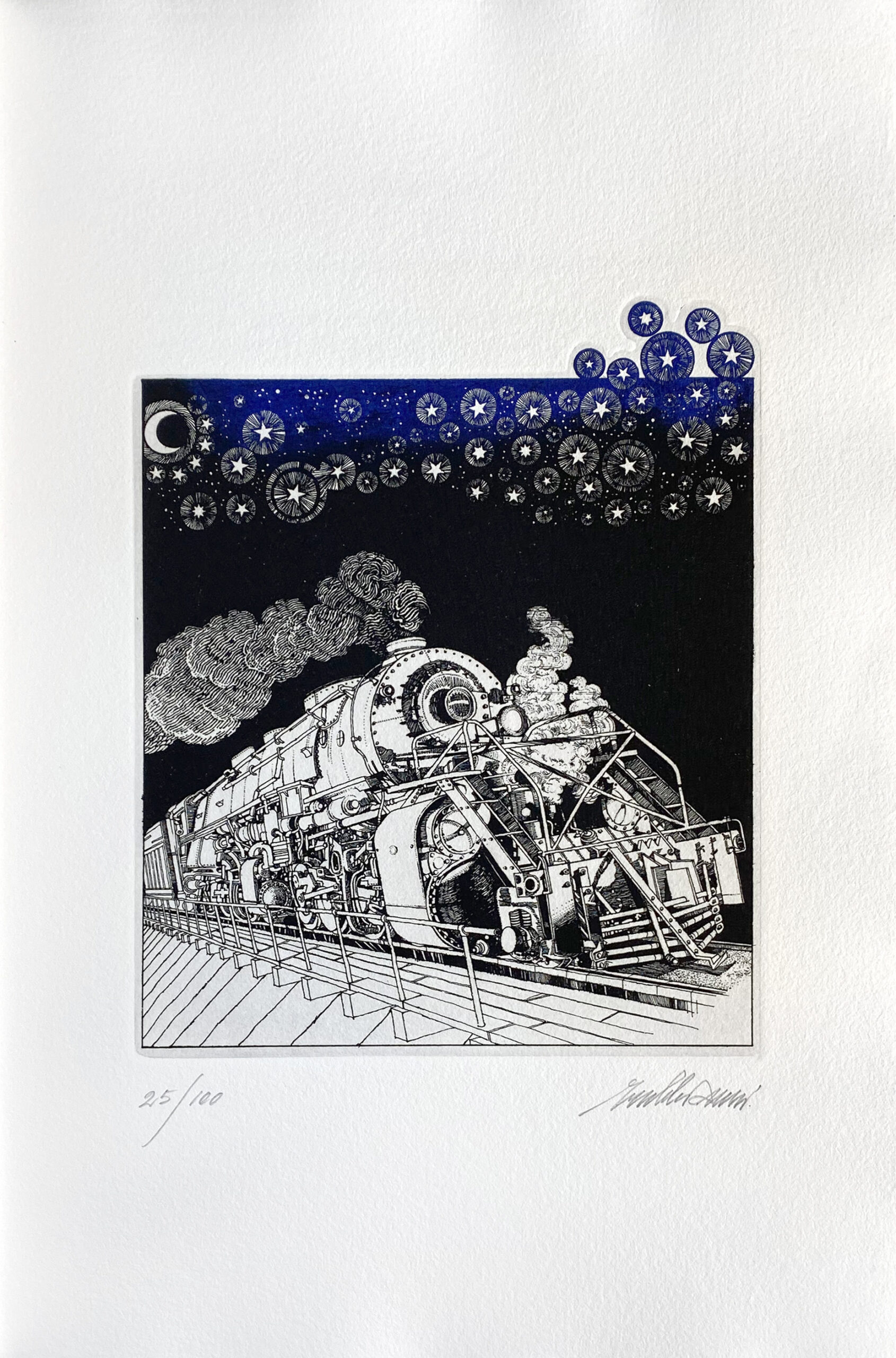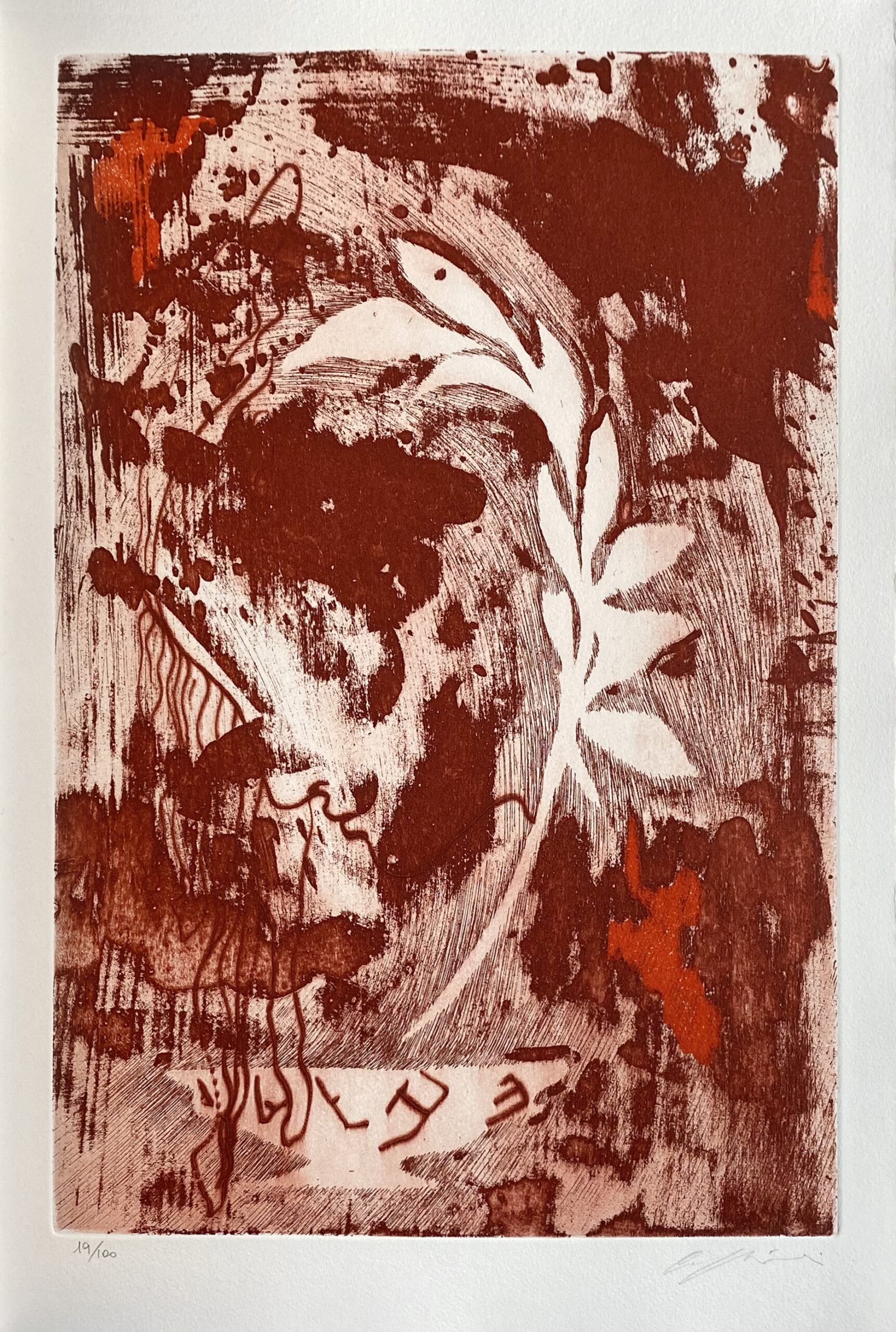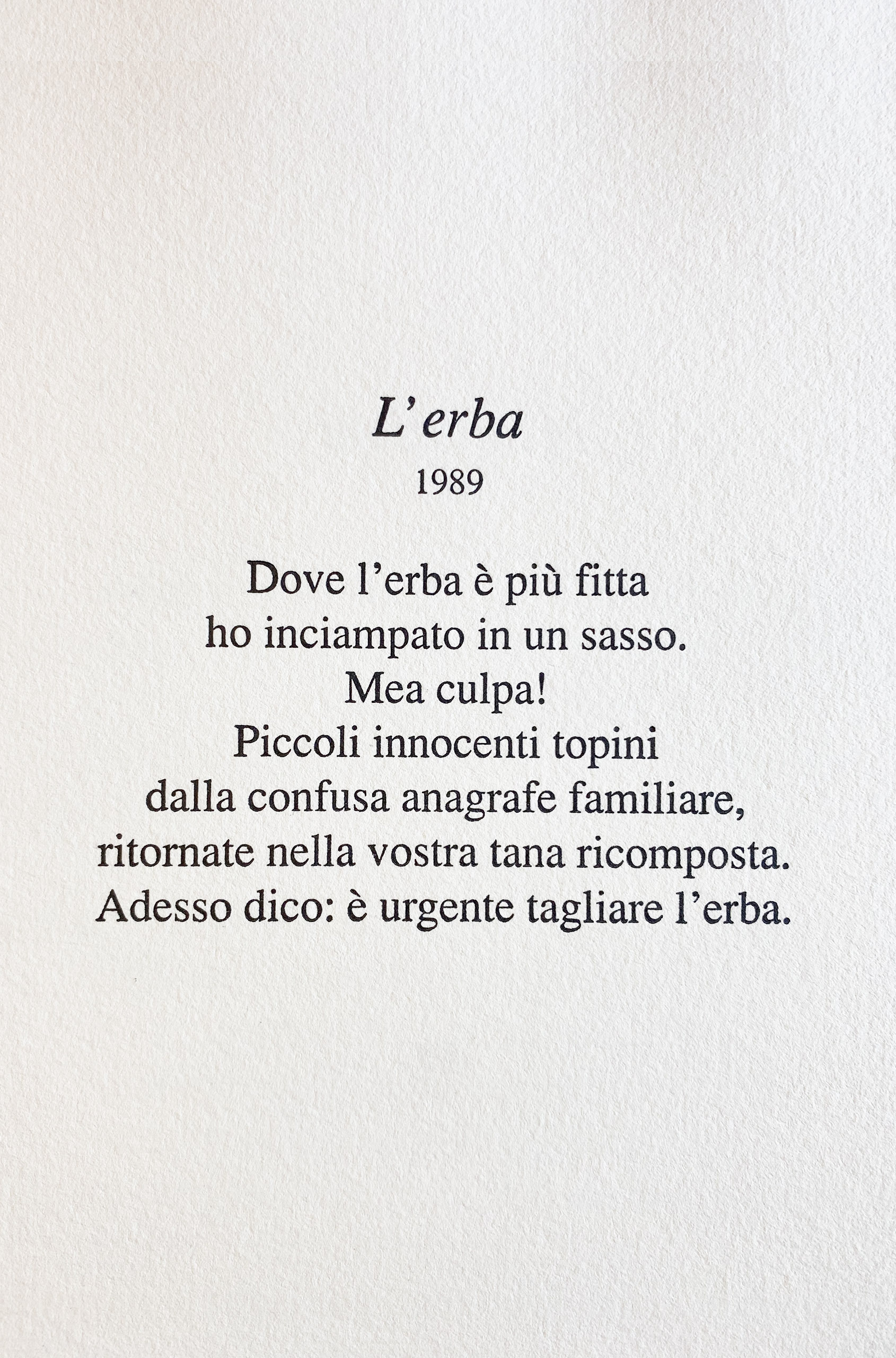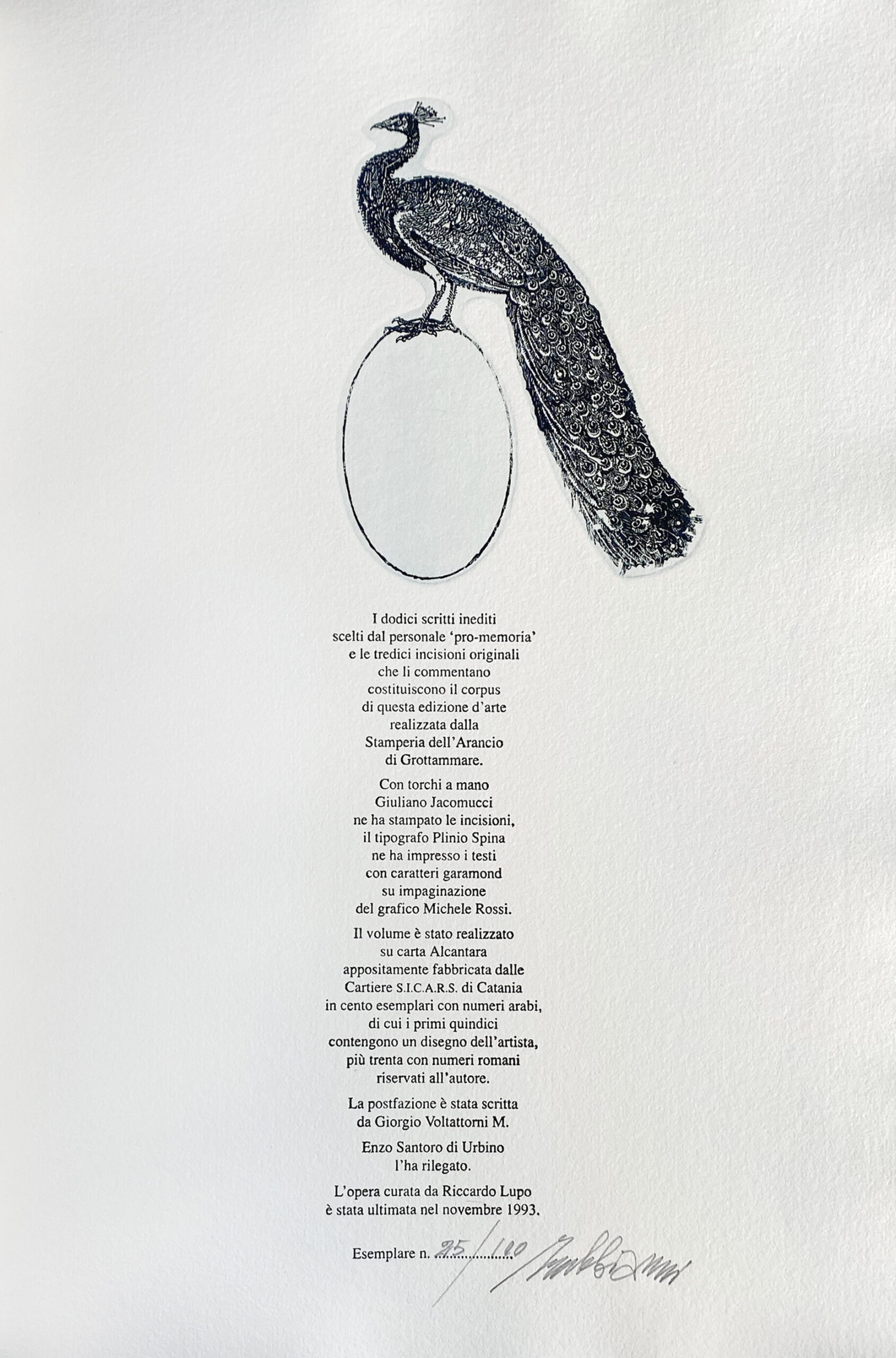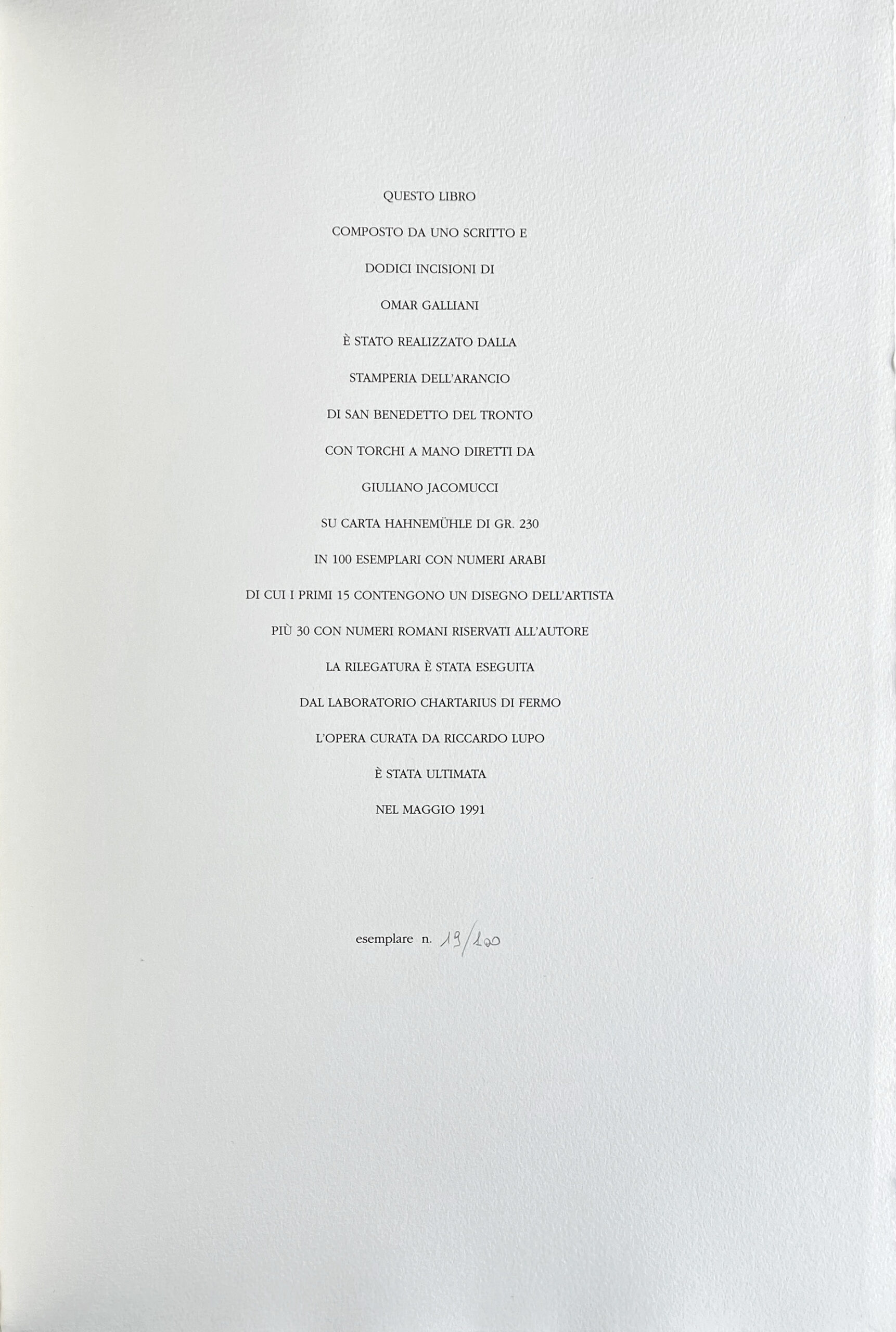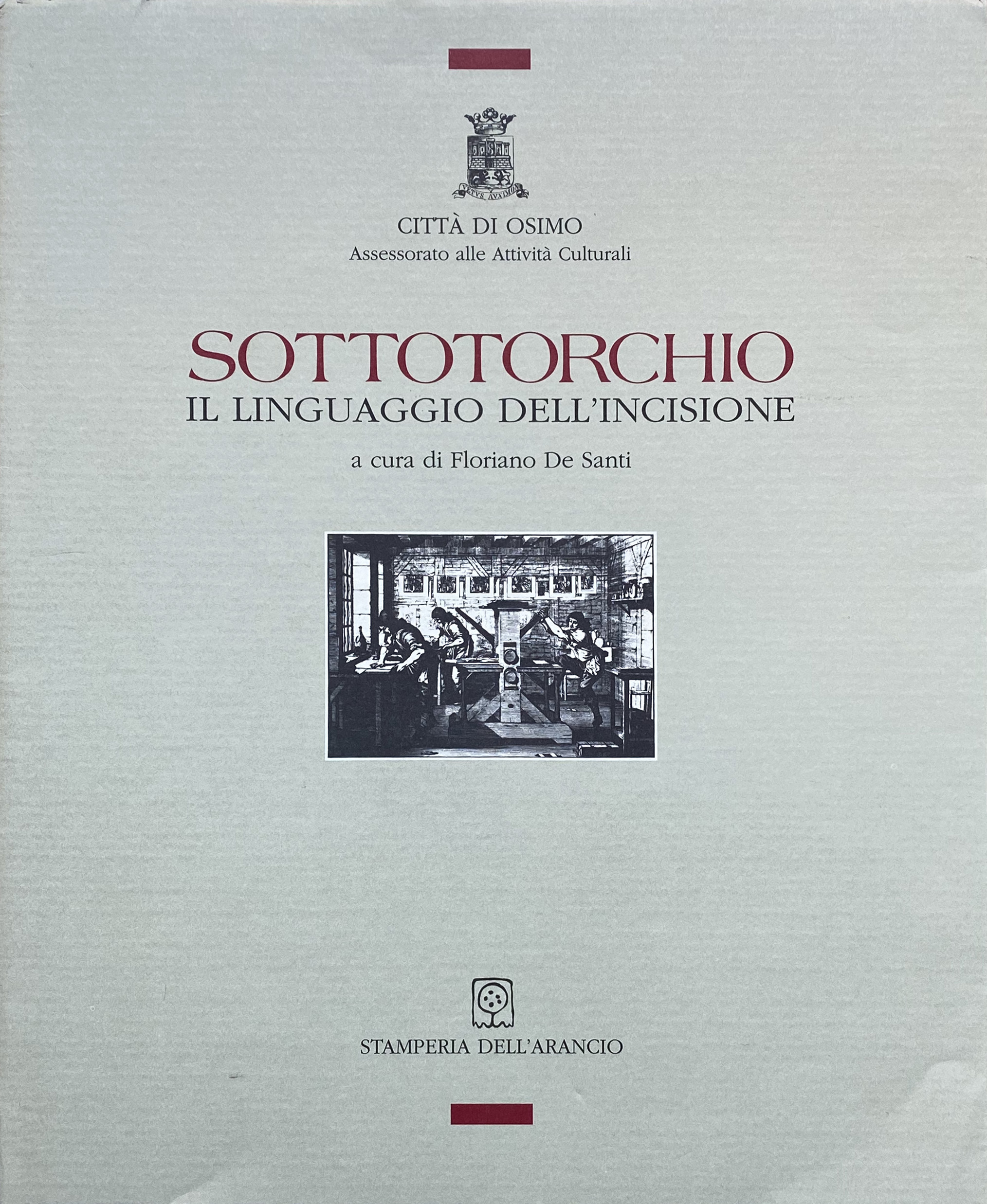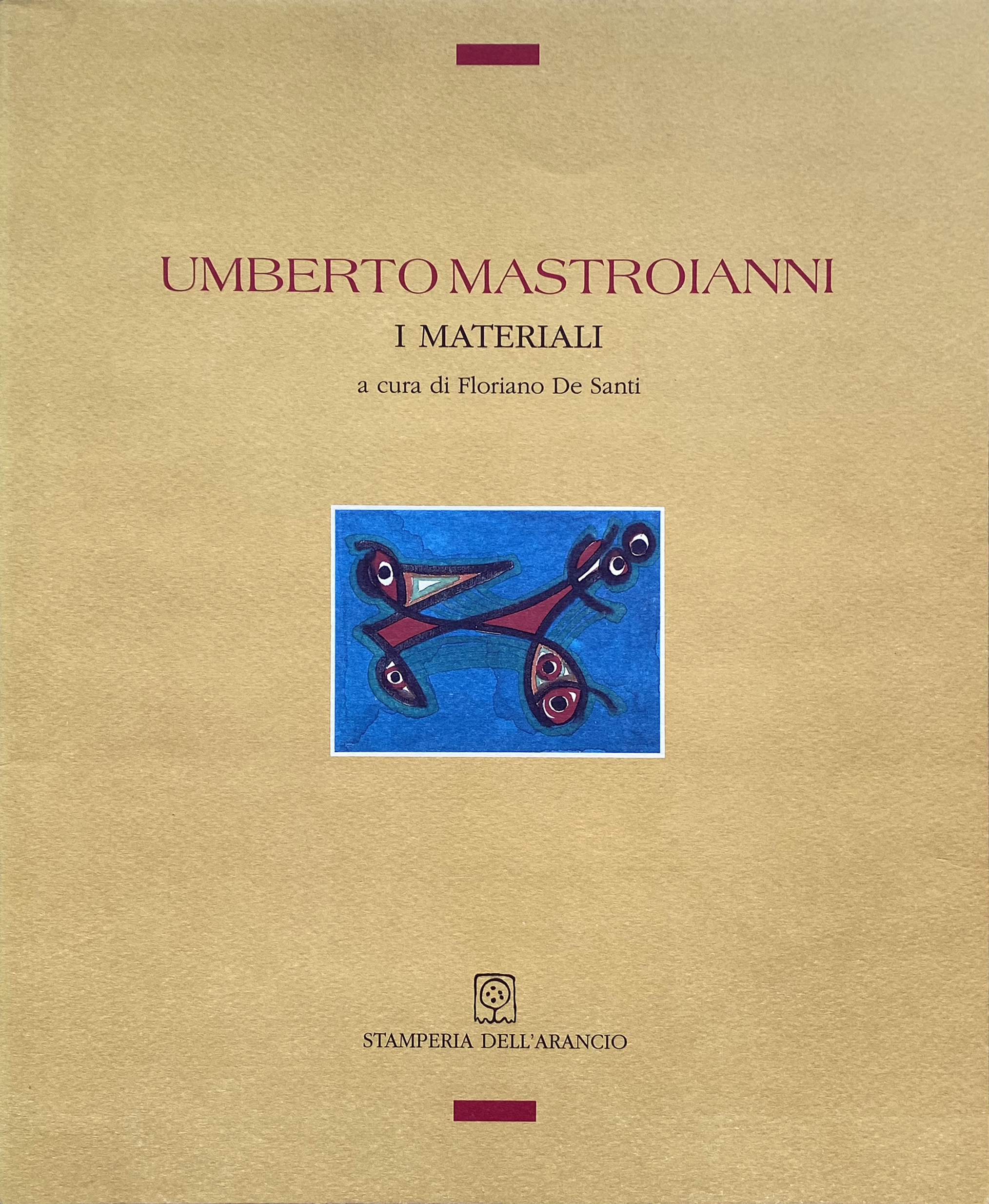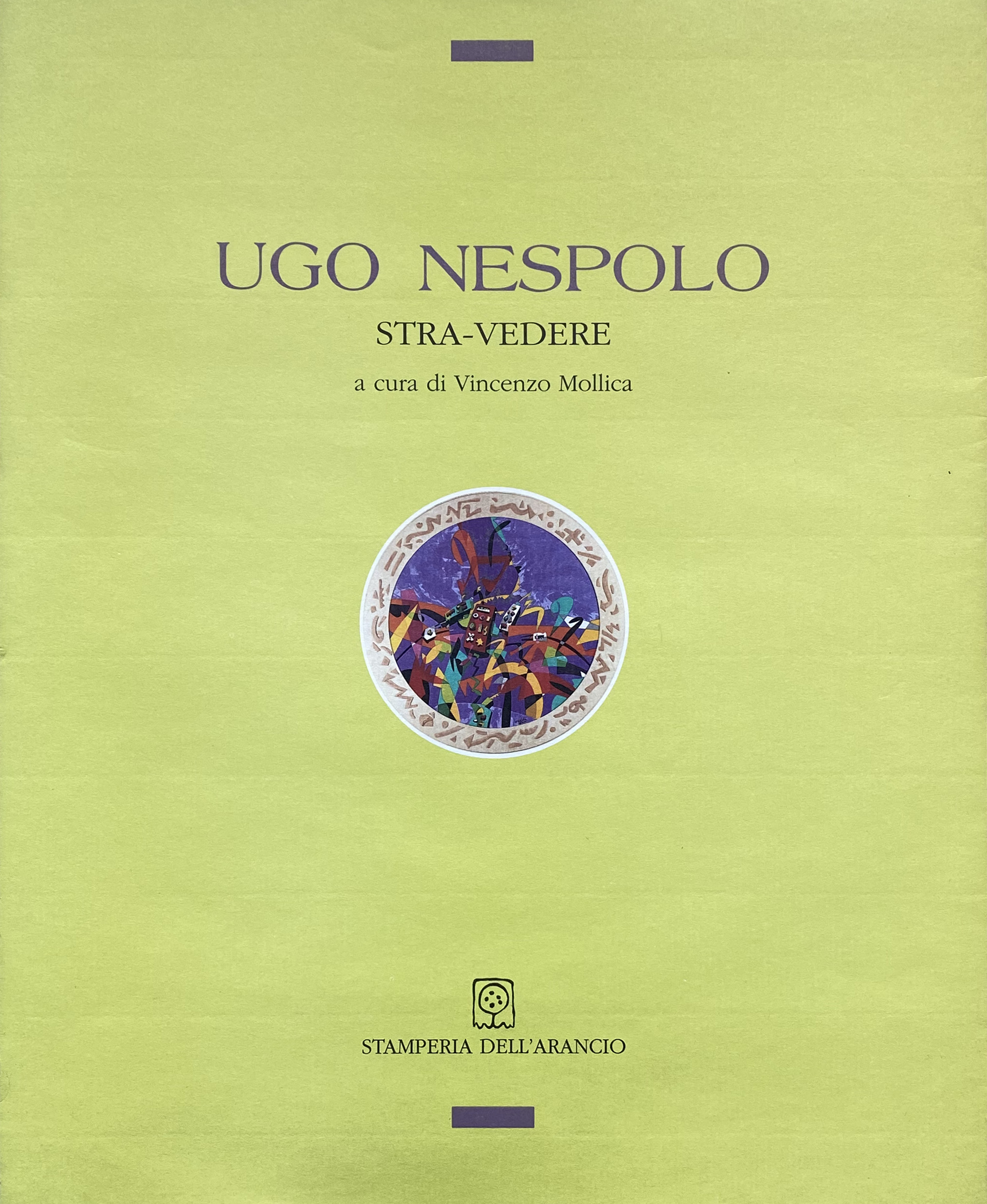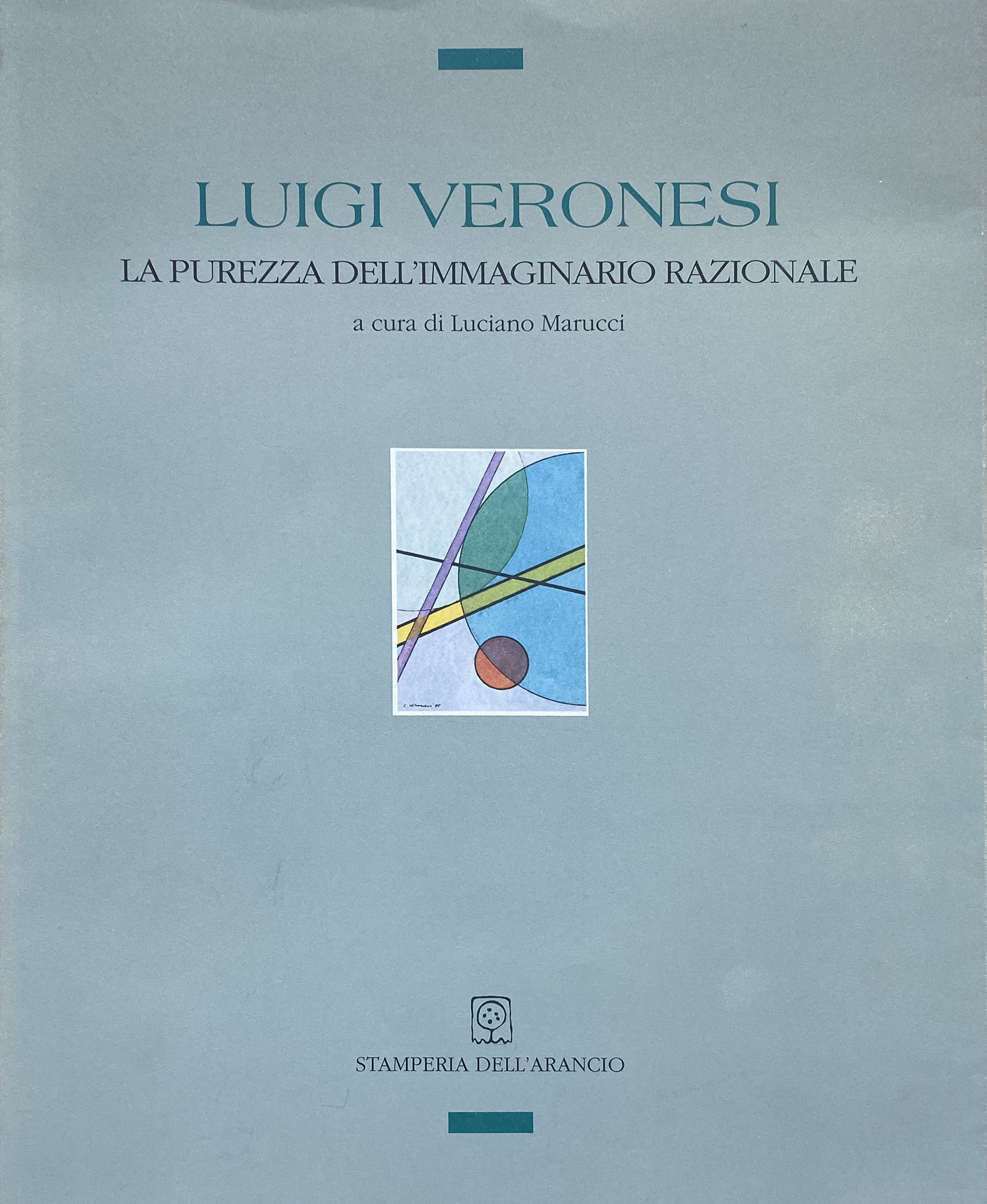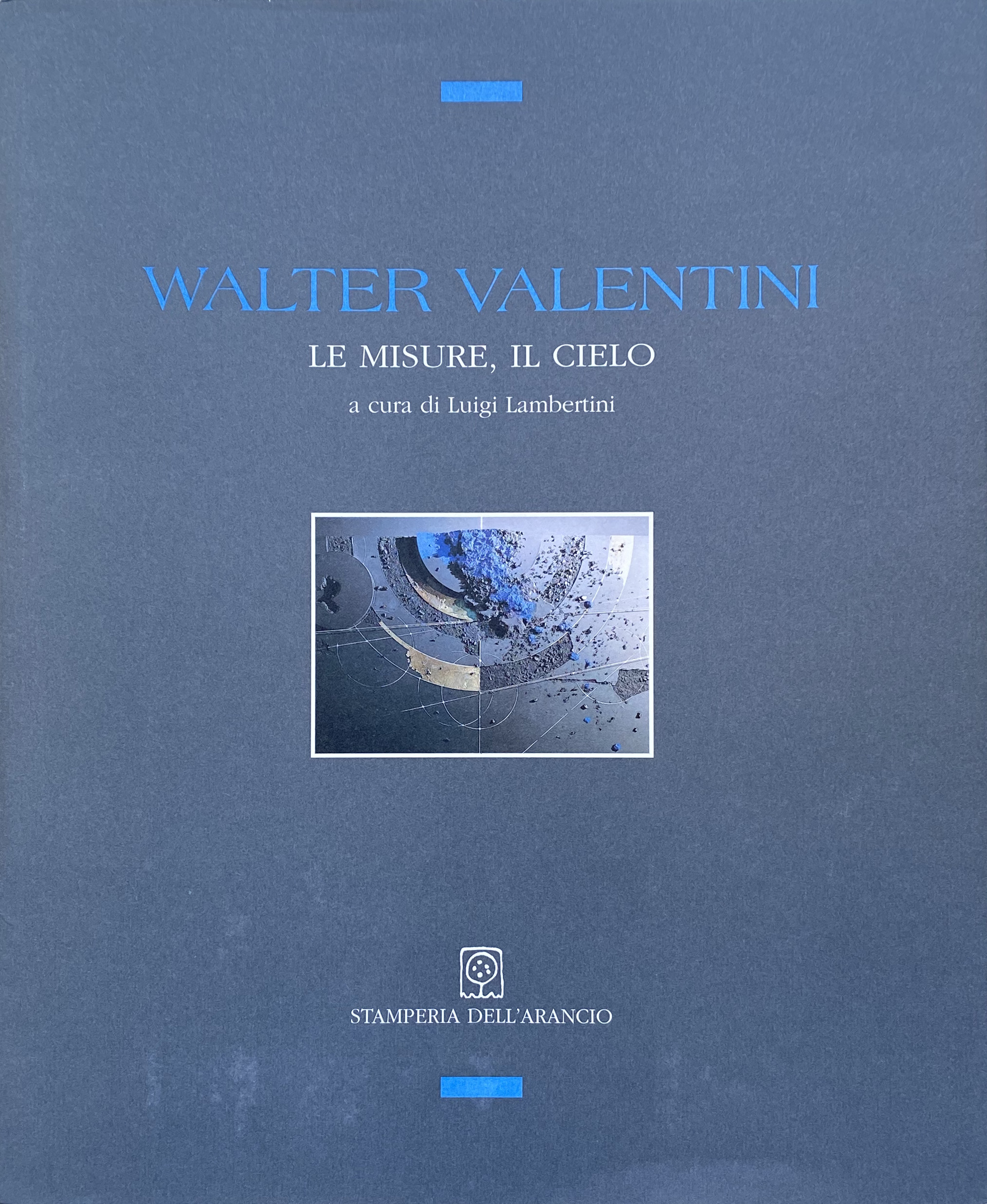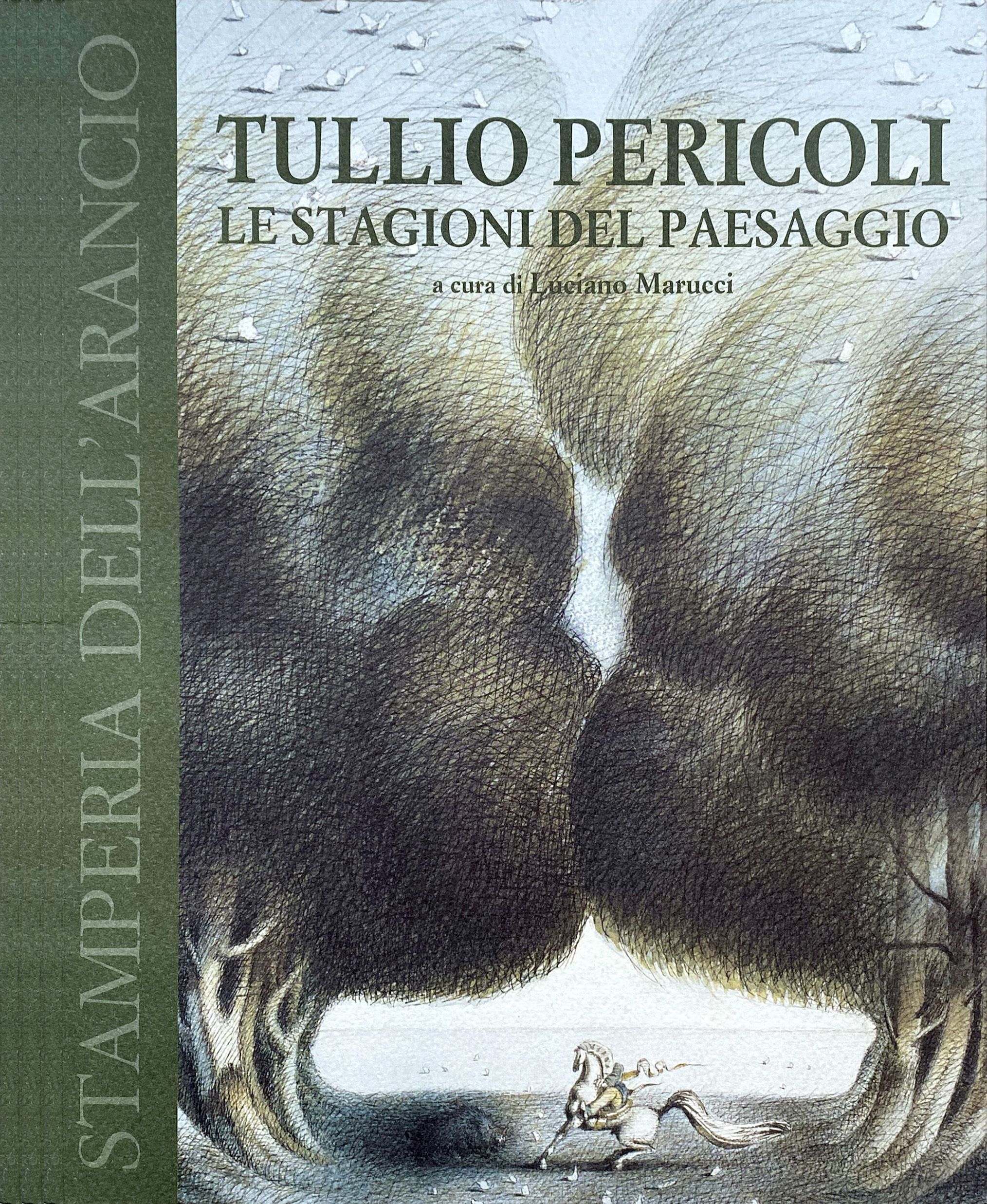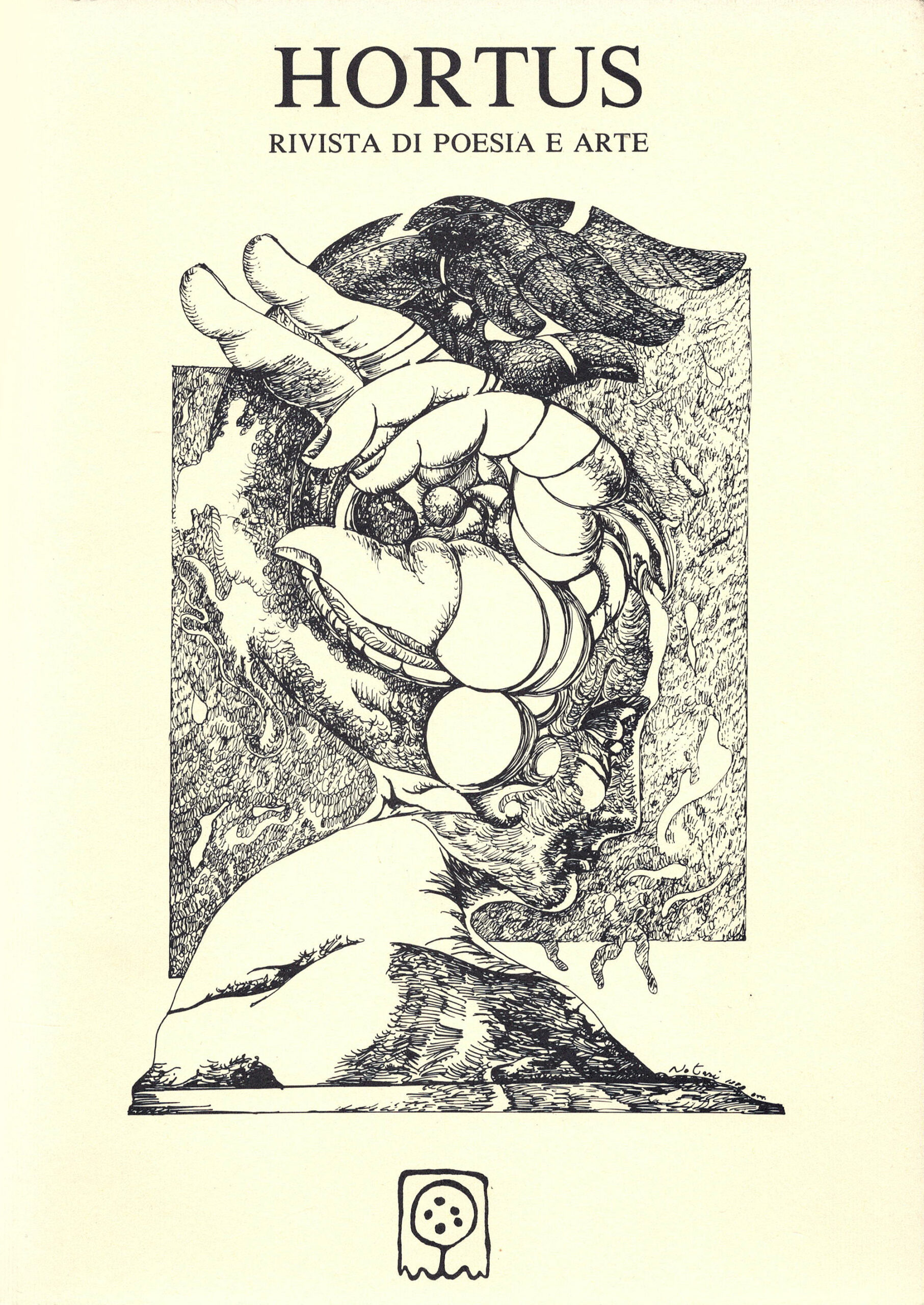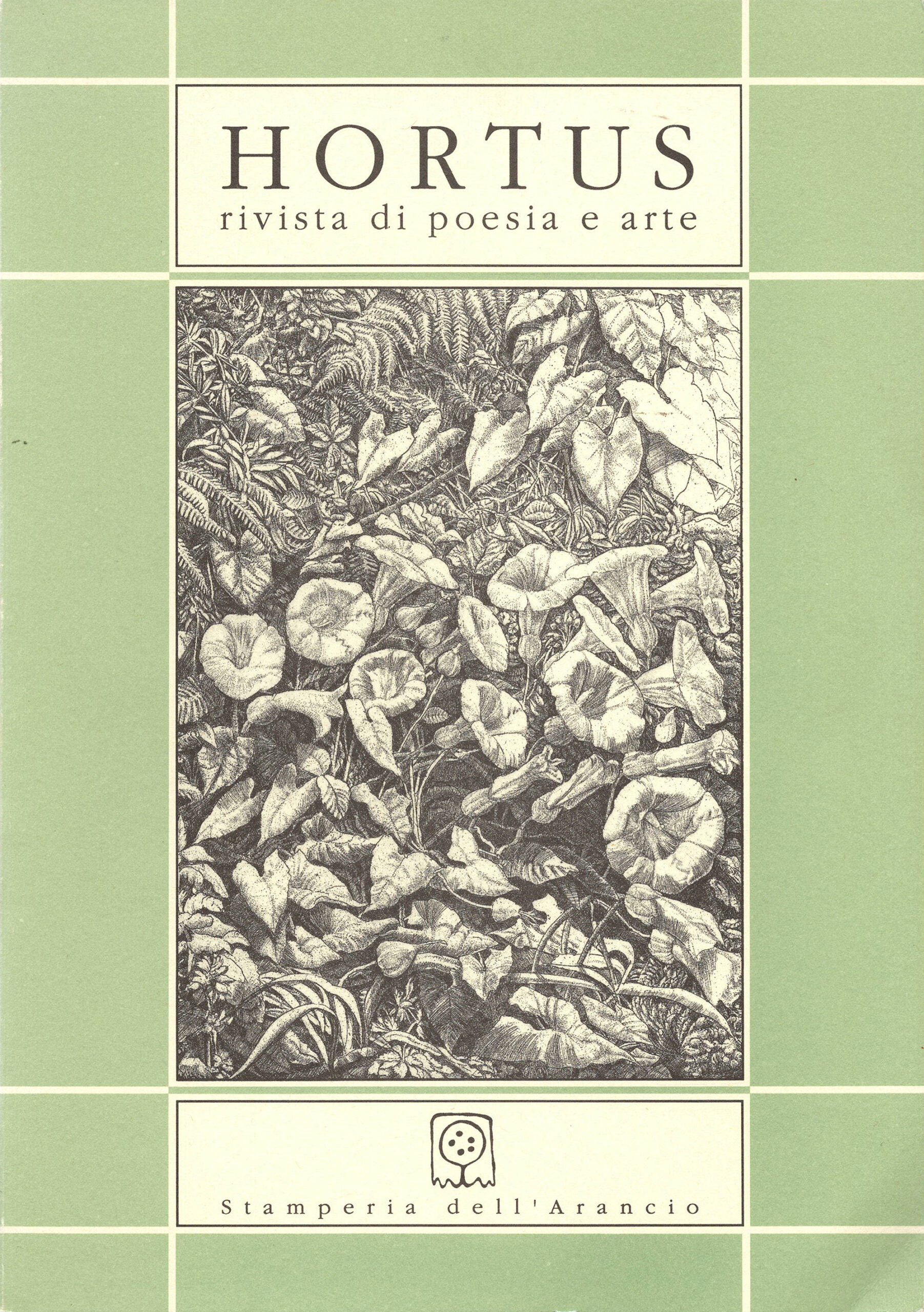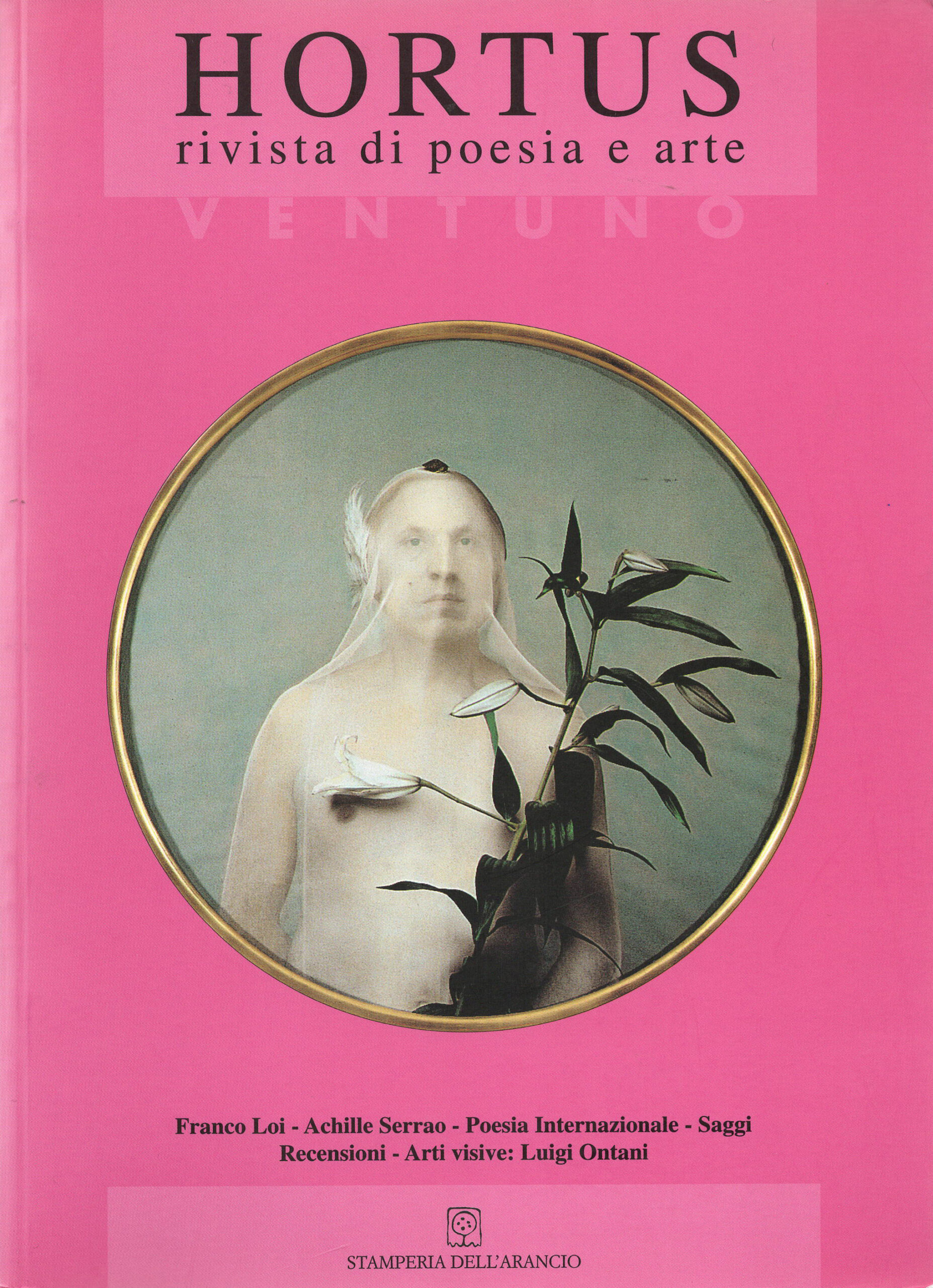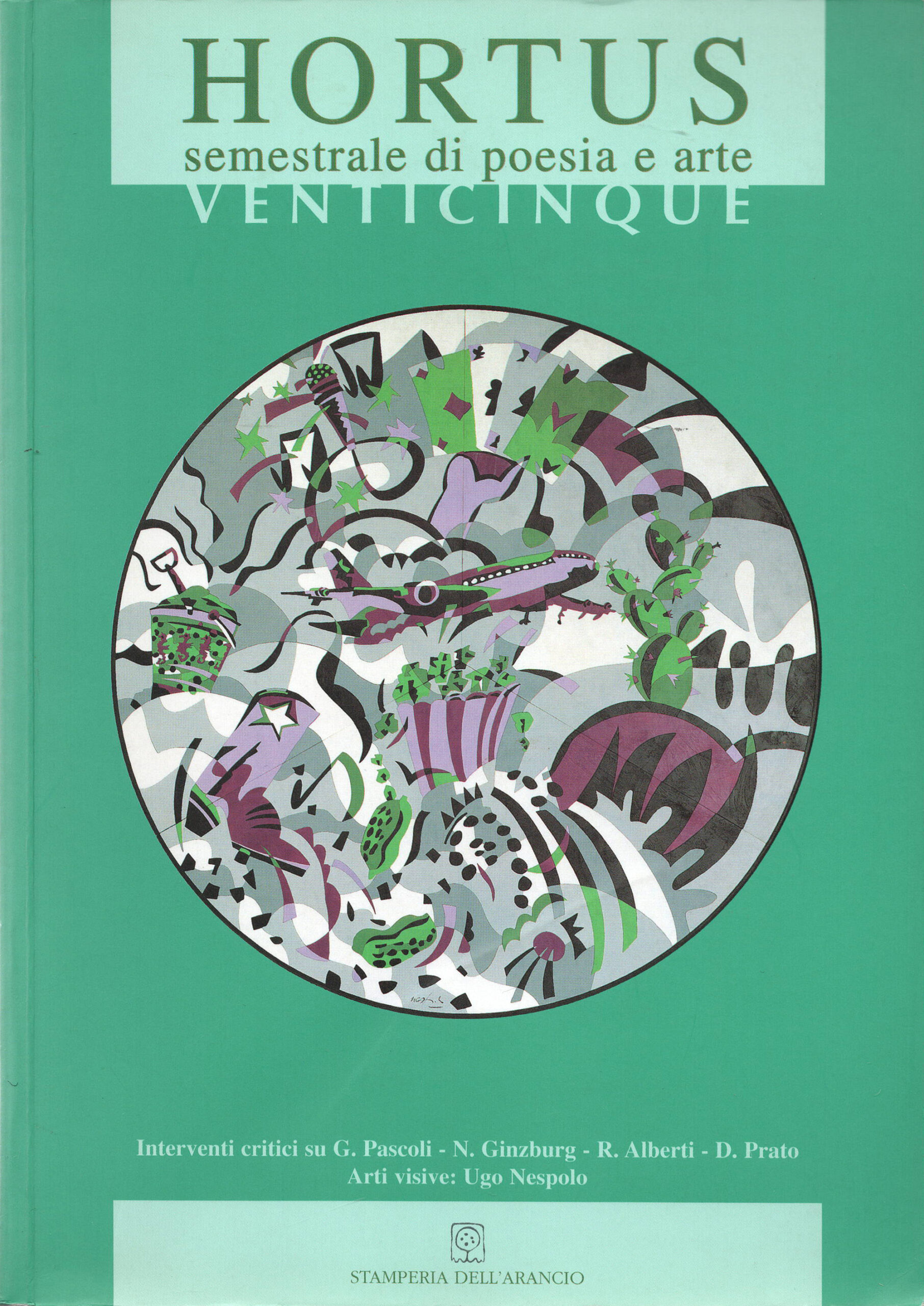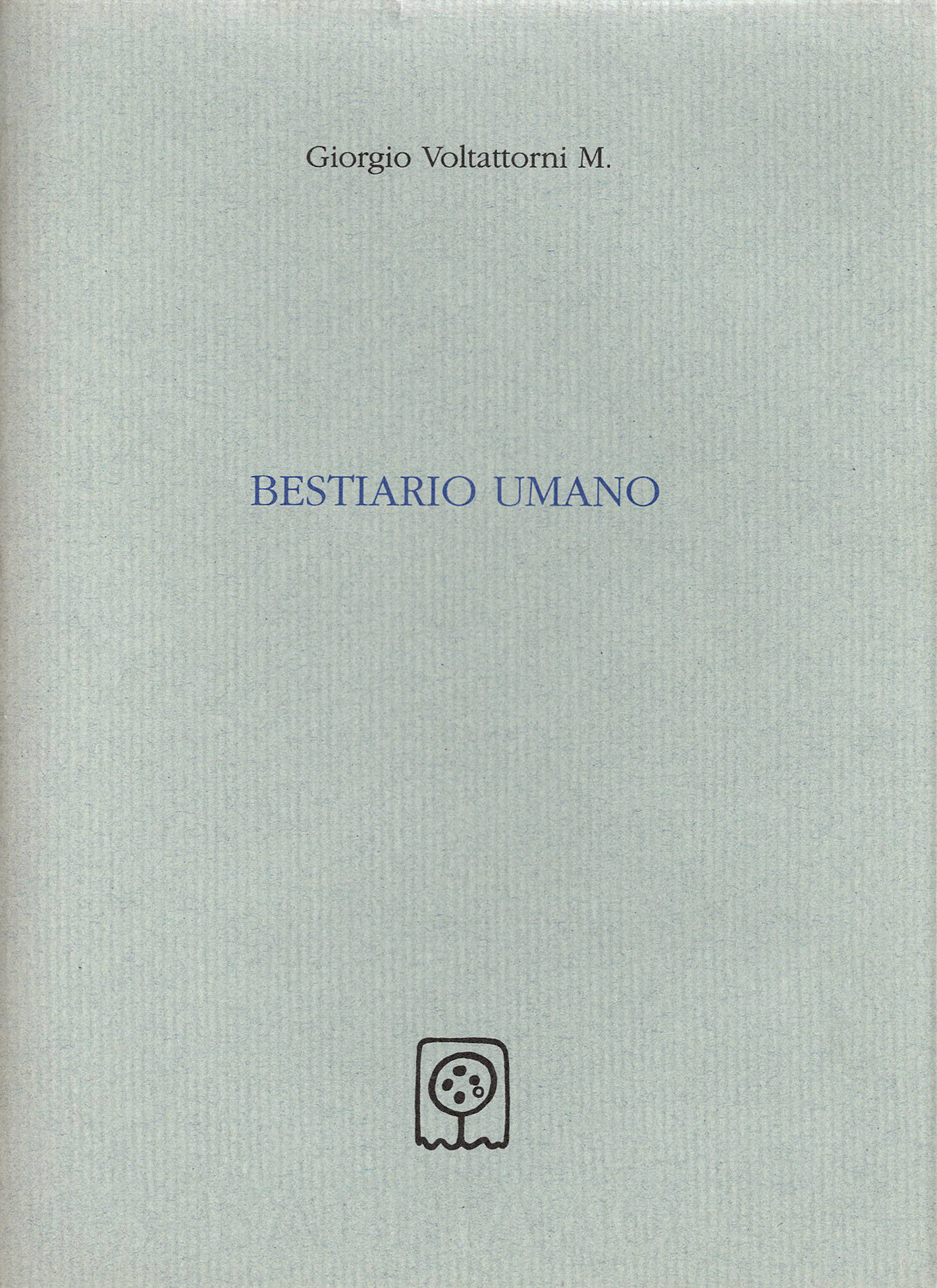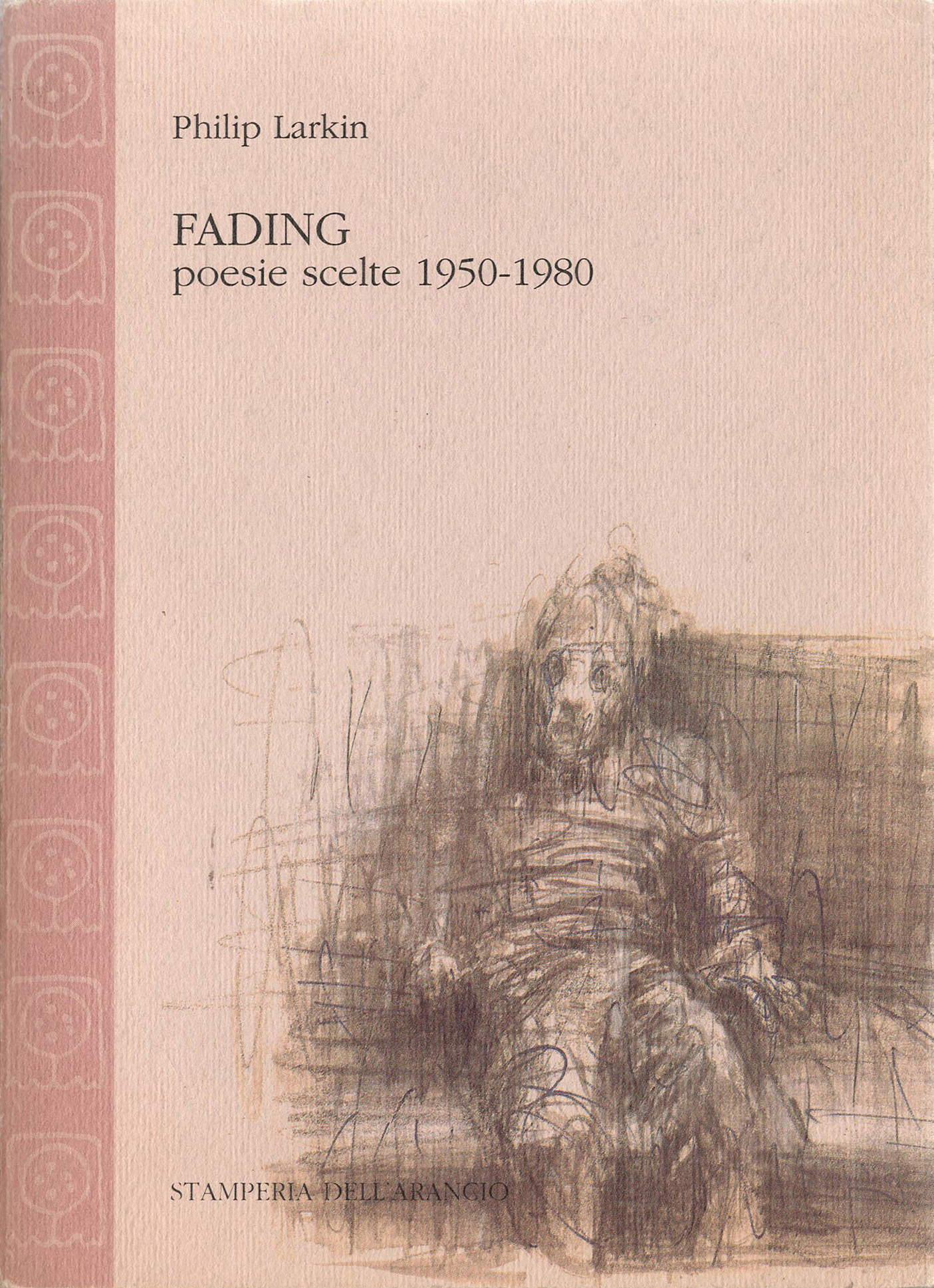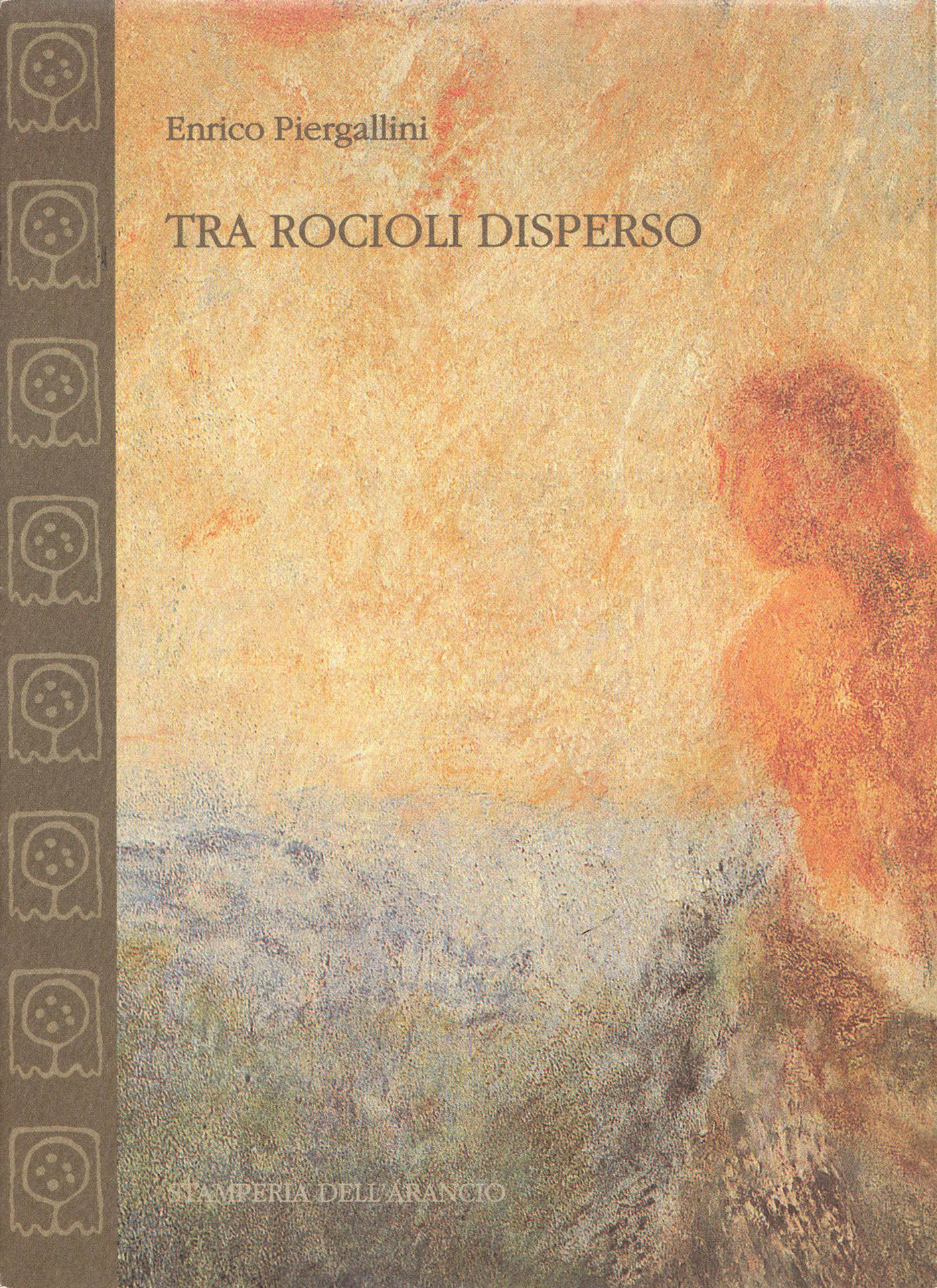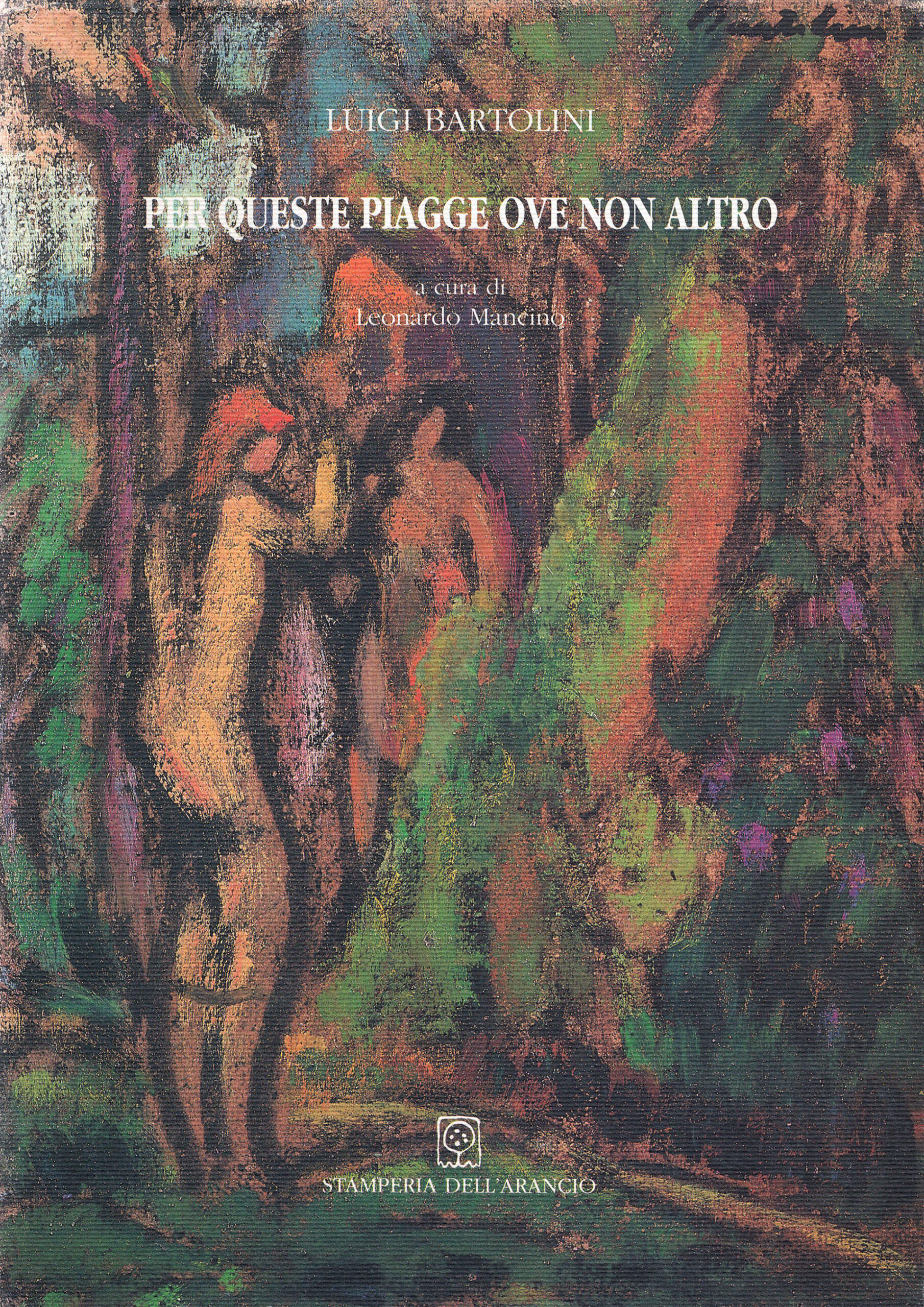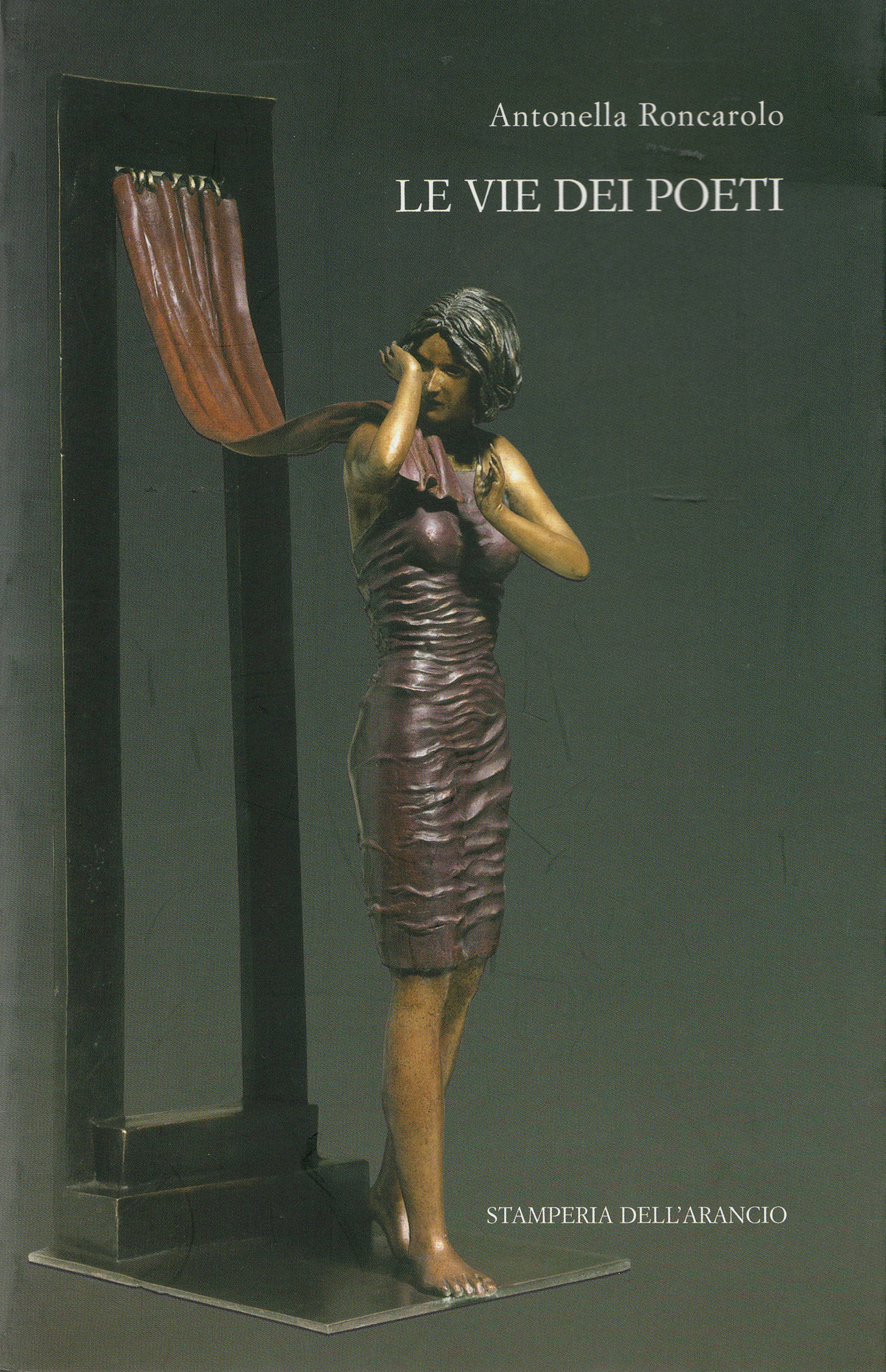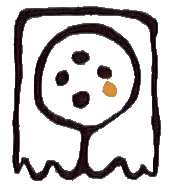
STAMPERIA DELL'ARANCIO
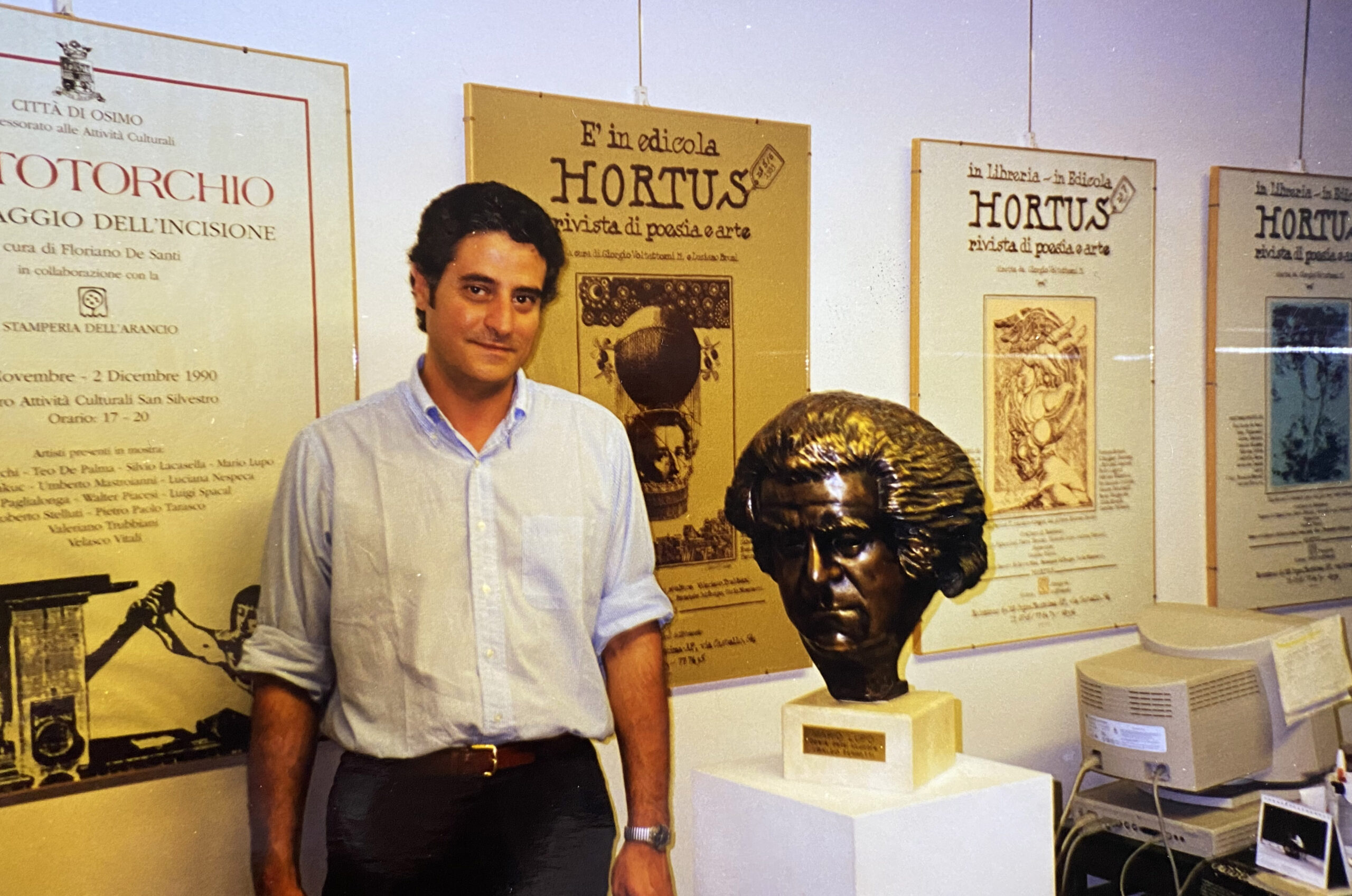 Stamperia dell'Arancio was founded in Grottammare Alta in the early eighties, in Mario Lupo's studio in the former Teatro dell'Arancio. His son, Riccardo, ran it with passion and outstanding commitment, working with the printer Giuliano Iacomucci. Back then, it mainly produced Mario Lupo's etchings and screenprints.
Stamperia dell'Arancio was founded in Grottammare Alta in the early eighties, in Mario Lupo's studio in the former Teatro dell'Arancio. His son, Riccardo, ran it with passion and outstanding commitment, working with the printer Giuliano Iacomucci. Back then, it mainly produced Mario Lupo's etchings and screenprints.
Stamperia dell'Arancio then moved to its own premises in San Benedetto del Tronto, on Via Fusinato. It expanded its skillset, becoming well known in the art world in the Italian region of Le Marche and beyond, to the point that many leading artists used it to print their work.
In 1988, Riccardo Lupo, as editor, gave new impetus to 'Hortus', a biannual poetry and art magazine (founded in 1987 by Giorgio Voltattorni M. and Luciano Bruni), which soon became known throughout Italy as a benchmark for the best poetic, literary and artistic production. Giorgio Voltattorni M. directed the magazine until 1991. He was succeeded by Eugenio De Signoribus and finally Leonardo Mancino. The critic Luciano Marucci curated Hortus’s extensive art section.
Riccardo Lupo also produced important, valuable art books, including 'Finestre' ('Windows') by Omar Galliani (containing twelve engravings) and 'Duello tra segno e parola' ('Duel between sign and word') by Valeriano Trubbiani (with thirteen engravings), printed in only 130 copies.
In 1992, with his father Mario Lupo's 'Burrasche' ('Storms') exhibition, he opened a space in Grottammare on Via Ischia, which included a printing house, gallery and publishing house under the same name. Stamperia dell'Arancio became a key reference point for intellectuals, artists, writers and collectors until 2006. In addition to producing top-quality artwork, the Gallery's programme included solo exhibitions of works by Umberto Mastroianni, Ugo Nespolo, Tullio Pericoli, Walter Valentini and Aligi Sassu, always accompanied by comprehensive catalogues that made up part of the 'Immaginazione' ('Imagination') series published by Stamperia. At the same time, the elegant and refined poetry publications, essays and novels stood out for their quality. Authors included Luigi Bartolini, Fabio Doplicher, Norman MacCaig, Philip Larkin, Libero Bigiaretti, Anna Cascella, Luigi Di Ruscio, Enrica Loggi, Lucilio Santoni and, of course, Giorgio Voltattorni M., Eugenio De Signoribus and Leonardo Mancino. Riccardo Lupo was responsible for the posthumous publication of works by Acruto Vitali and Remo Pagnanelli.
Critics such as Achille Bonito Oliva and Floriano De Santi attended the openings of the painting exhibitions, while the book presentations attracted a broad, interested and enthusiastic public. Writers and art experts, poets, painters and sculptors met at Stamperia dell'Arancio, where innovative projects were designed and developed.
Riccardo Lupo, profoundly cultured and passionate about art and always with an open ear, successfully promoted emerging artists and writers.
He passed away before his time on 23 May 2020, but his exceptional work as a publisher, gallery owner and printer lives on.
TESTIMONIALS
(from the catalogue for Mario Lupo's exhibition 'Burrasche' at Stamperia dell'Arancio - 1991)
In the space of a few years, Stamperia dell'Arancio grew tremendously. This was to be expected, although no one would have imagined that it would reach such a high technical level, which awarded it the status it deserved. It was born, as if on the deck of a ship, high up on the cliff of Grottammare in the old part of the town, in the little square named after Sixtus V, whose hideous statue stands grimly in a recess. That piazza near the Town Hall is also home to Teatro dell'Arancio (Orange Tree Theatre), after which the print shop was named. The studio of painter Mario Lupo, the print shop's progenitor, was also there, of course. We should add that the wind and colour of the Adriatic appeared on the first printed sheets, because of the relationship between a mature painter and a young man who had a passion for artwork. He decided to stay, as they say, in the business, out of admiration for his father and his socialising with friends who had studied the art of engraving. I can testify to the straightforwardness and friendliness of Riccardo Lupo, whom I met when he moved his engraving workshop to San Benedetto.
I remember him listening attentively when we talked about prints, printers, ancient and modern engraving, wood and copper engraving, paper, layout and bodies, or referred to the great Italian printer-publishers of today. Riccardo listened, and when he chimed in with a question or comment, it was always remarkably on point. A few words sufficed to see that he was serious about doing something more than his tools and space at the time would allow.
In short, the 'child of art' had no desire to tear off a single leaf from the laurels of anyone else, even though he had inherited the example of professional probity and human gallantry from his father. A short time ago, I listened to him agog and was quite moved by what he told me about this relationship: 'If it hadn't been for my father's example, I would never have been a printer, and I know that I will always improve. But then I know that I won't just focus on the financial aspects of the job but first and foremost on the pleasure of being in what I believe is a creation and that the relationship with the artists enriches and nourishes ... '.
I must say that today, such a profession is very rare among young people, who, above all, want to deny their roots and connections (and this is terrible).
This inauguration of the new premises - already in operation - confirms, beyond any words, the path taken by Stamperia dell'Arancio. It is an essential cultural asset for Grottammare and the Le Marche region, and I am confident it will receive the interest it deserves. I know that we people of Le Marche don't pay much attention to culture, although I have the impression that art and everything related to art are an exception. After all, Riccardo's publications honour Italian art publishing and thus the city, and he achieved what he set out to do.
It is fascinating to think that this area used to make building bricks and tiles, and now it churns out other kinds of things that are no less useful for people: fragments of beauty and words that help people live. However, the vital detail that shows that the printer kept his promises is the beautiful adjoining gallery.
It will be used for the permanent exhibition of publishing work - the folders, books, and engravings - and for presentations and solo exhibitions of contemporary artists. I don't know about future programmes: I know that after the first exhibition, another one is scheduled. But I know that the choice and quality of the exhibitions will be as exacting as the print quality.
Thus, a new gallery is not just a passing fancy but a demanding choice of profession. A gallery seeking to create culture by contributing to the knowledge of art, doing so without arrogance but with enthusiasm and wisdom. We wish them well for the future, which has already begun, and we do so with a smile on our faces, because if the gallery works as well as the print shop, I think we are on safe ground. I would like to add one thing in expressing my warm wishes: Riccardo knew how to listen and had the wisdom, rare in young people, not to discount others who have already gained experience. Again, I refer to the quality of his work in engraving and the esteem in which he has been held by the artists (who, as everyone knows, are impossible to please), to be sure that the gallery's activities will be equally dependable.
22 February 2016
In 1987, when Eugenio De Signoribus, Luciano Bruni and I started producing a small poetry and art magazine, we were supported by a tiny publishing house in San Benedetto del Tronto, Laberinto di L. Cocci Grifoni.
As early as the third issue, the Stamperia dell'Arancio logo appeared on the cover of Hortus. Our close cooperation with Riccardo allowed us to improve the magazine in terms of 'materials' and distribution and to combine each issue with an etching specially made by the artists (and intended for supporting subscribers). [...]
We achieved a degree of stability with Stamperia and could finally plan the 'nature' (the content) and guarantee the frequency of publication. When the first issue came out, we weren't sure whether there would be a second one, and the same was true of the second issue. The number of pages increased considerably with four-colour printing, and the artists involved were always Italian or even European, such as Mastroianni, Ontani, Dorazio, Accardi, Pericoli, Trubbiani, Spacal, Pericoli, Galliani and Ceccobelli, to name but a few. [...]
In our neck of the woods, we no longer have a poetry and art magazine the likes of Hortus. Non-fiction and poetry books are no longer printed, nor are catalogues, monographs or special art editions in folders or volumes, where the literary word is 'accompanied' by engraving, the noblest of the 'serial' techniques.
Artists of the calibre of Trubbiani, Pericoli, Spacal, Mastroianni, Nespolo, Luca Maria Patella, Galliani, Ceccobelli and Velasco, to name but a few, no longer frequent this increasingly isolated provincial patch of province...
25 May 2020
His dream, Stamperia dell'Arancio will remain for a long, long time the only example of private cultural enterprise whose breadth of vision and quality of offering enables it to aspire to the value of a public space.
An elegant, refined place, a meeting point for intellectuals and art experts: some of Stamperia's poetry books and catalogues still play a leading role in the history of Italian publishing.
For many years, Riccardo's dream helped a 'province' to feel at the 'heart' of Italian culture. A fundamental change of gravity that today, 20 years later, seems impossible.
24 May 2020
My memory of Riccardo Lupo is inextricably linked to the early 1990s, up to 1996. This was when 'Hortus' (the poetry and art magazine founded in Cupra in 1987 with friends Giorgio Voltattorni M. and Luciano Bruni) transformed from a local cultural venture to a valuable reference point for national poetry and critical literature. Riccardo was the publisher and worked with the talented printer Giuliano Lacomucci (for the art prints almost always combined with the poetry editions) and other cultural figures. These included the then young Marco Fazzini (now professor of English literature at the Ca' Foscari in Venice) and Luciano Marucci, the historical curator of the memorable Sambenedettesi Art Biennales of the 1960s. Riccardo Lupo brought to light posthumous works by Acruto Vitali and Remo Pagnanelli, among the most influential recent poetical voices in the Le Marche region. [...]
28 May 2020
I met Riccardo as a student, when he opened a three-level gallery that was the envy of international galleries, connected to an art printing house and a publishing house. It was there that I first exhibited my canvases, and his admiring curiosity was, above all, an encouragement for me to do well, to do better. His enthusiasm led me to see not only the works I had already done, but all the works I would go on to do. Those big walls demanded a broad sweep and the ambition to 'bear' all the culture they contain as an overwhelming weight. Its rich library kept me immersed as if in an aquarium, where you could discover artists you had never seen before, except at ArtBasel or the Biennale.
In the gallery, I met leading intellectuals, artists, critics, writers and poets at a time when there was a desire for direct knowledge, a willingness to listen and authentic sharing.
One day when I came back from Udine, where I had exhibited a series of children's portraits, I gave him the catalogue as a present, and when he saw it, he said: "Let's do the sequel. I'll cover the expenses." The same happened a few years ago, when he quietly leafed through my black and white photos of Mara and said: 'This story contains a message that maybe even you can't imagine, let's tell it.' This intuition led to the first volume, Mara as Muse, and for the first time in the history of art, an artist placed not himself but his muse in the foreground.
12 February 2021
Some time ago, twenty years or more, there was a place that was a vital reference point for painters, poets, sculptors and art lovers.
Going there was a feast for the eyes and mind, also for me. We are talking about Riccardo Lupo's Stamperia dell'Arancio in Grottammare. In the beginning, I came here because I wanted to get to know him, to breathe in the all-round atmosphere of art. Then, as my friendship with Riccardo grew, an increasingly vast, articulated and practically complete world opened up. On the one hand, the typographic and editorial work on art history with in-depth publications, on the other hand, high-quality production of lithographs, woodcuts and screenprints. There were also exhibitions of emerging artists, and the promotion of local art, poetry and fiction through the six-monthly magazine Hortus.
Riccardo was full of initiatives, a lover of art like few others, and a true enthusiast with existential and philosophical implications.
SOME WORKS PRODUCED BY STAMPERIA DELL'ARANCIO
GRAPHICS FOLDERS

STAMPERIA DELL'ARANCIO

Stamperia dell'Arancio was founded in Grottammare Alta in the early eighties, in Mario Lupo's studio in the former Teatro dell'Arancio. His son, Riccardo, ran it with passion and outstanding commitment, working with the printer Giuliano Iacomucci. Back then, it mainly produced Mario Lupo's etchings and screenprints.
Stamperia dell'Arancio then moved to its own premises in San Benedetto del Tronto, on Via Fusinato. It expanded its skillset, becoming well known in the art world in the Italian region of Le Marche and beyond, to the point that many leading artists used it to print their work.
In 1988, Riccardo Lupo, as editor, gave new impetus to 'Hortus', a biannual poetry and art magazine (founded in 1987 by Giorgio Voltattorni M. and Luciano Bruni), which soon became known throughout Italy as a benchmark for the best poetic, literary and artistic production. Giorgio Voltattorni M. directed the magazine until 1991. He was succeeded by Eugenio De Signoribus and finally Leonardo Mancino. The critic Luciano Marucci curated Hortus’s extensive art section.
Riccardo Lupo also produced important, valuable art books, including 'Finestre' ('Windows') by Omar Galliani (containing twelve engravings) and 'Duello tra segno e parola' ('Duel between sign and word') by Valeriano Trubbiani (with thirteen engravings), printed in only 130 copies.
In 1992, with his father Mario Lupo's 'Burrasche' ('Storms') exhibition, he opened a space in Grottammare on Via Ischia, which included a printing house, gallery and publishing house under the same name. Stamperia dell'Arancio became a key reference point for intellectuals, artists, writers and collectors until 2006. In addition to producing top-quality artwork, the Gallery's programme included solo exhibitions of works by Umberto Mastroianni, Ugo Nespolo, Tullio Pericoli, Walter Valentini and Aligi Sassu, always accompanied by comprehensive catalogues that made up part of the 'Immaginazione' ('Imagination') series published by Stamperia. At the same time, the elegant and refined poetry publications, essays and novels stood out for their quality. Authors included Luigi Bartolini, Fabio Doplicher, Norman MacCaig, Philip Larkin, Libero Bigiaretti, Anna Cascella, Luigi Di Ruscio, Enrica Loggi, Lucilio Santoni and, of course, Giorgio Voltattorni M., Eugenio De Signoribus and Leonardo Mancino. Riccardo Lupo was responsible for the posthumous publication of works by Acruto Vitali and Remo Pagnanelli.
Critics such as Achille Bonito Oliva and Floriano De Santi attended the openings of the painting exhibitions, while the book presentations attracted a broad, interested and enthusiastic public. Writers and art experts, poets, painters and sculptors met at Stamperia dell'Arancio, where innovative projects were designed and developed.
Riccardo Lupo, profoundly cultured and passionate about art and always with an open ear, successfully promoted emerging artists and writers.
He passed away before his time on 23 May 2020, but his exceptional work as a publisher, gallery owner and printer lives on.
TESTIMONIALS
(from the catalogue for Mario Lupo's exhibition 'Burrasche' at Stamperia dell'Arancio - 1991)
In the space of a few years, Stamperia dell'Arancio grew tremendously. This was to be expected, although no one would have imagined that it would reach such a high technical level, which awarded it the status it deserved. It was born, as if on the deck of a ship, high up on the cliff of Grottammare in the old part of the town, in the little square named after Sixtus V, whose hideous statue stands grimly in a recess. That piazza near the Town Hall is also home to Teatro dell'Arancio (Orange Tree Theatre), after which the print shop was named. The studio of painter Mario Lupo, the print shop's progenitor, was also there, of course. We should add that the wind and colour of the Adriatic appeared on the first printed sheets, because of the relationship between a mature painter and a young man who had a passion for artwork. He decided to stay, as they say, in the business, out of admiration for his father and his socialising with friends who had studied the art of engraving. I can testify to the straightforwardness and friendliness of Riccardo Lupo, whom I met when he moved his engraving workshop to San Benedetto.
I remember him listening attentively when we talked about prints, printers, ancient and modern engraving, wood and copper engraving, paper, layout and bodies, or referred to the great Italian printer-publishers of today. Riccardo listened, and when he chimed in with a question or comment, it was always remarkably on point. A few words sufficed to see that he was serious about doing something more than his tools and space at the time would allow.
In short, the 'child of art' had no desire to tear off a single leaf from the laurels of anyone else, even though he had inherited the example of professional probity and human gallantry from his father. A short time ago, I listened to him agog and was quite moved by what he told me about this relationship: 'If it hadn't been for my father's example, I would never have been a printer, and I know that I will always improve. But then I know that I won't just focus on the financial aspects of the job but first and foremost on the pleasure of being in what I believe is a creation and that the relationship with the artists enriches and nourishes ... '.
I must say that today, such a profession is very rare among young people, who, above all, want to deny their roots and connections (and this is terrible).
This inauguration of the new premises - already in operation - confirms, beyond any words, the path taken by Stamperia dell'Arancio. It is an essential cultural asset for Grottammare and the Le Marche region, and I am confident it will receive the interest it deserves. I know that we people of Le Marche don't pay much attention to culture, although I have the impression that art and everything related to art are an exception. After all, Riccardo's publications honour Italian art publishing and thus the city, and he achieved what he set out to do.
It is fascinating to think that this area used to make building bricks and tiles, and now it churns out other kinds of things that are no less useful for people: fragments of beauty and words that help people live. However, the vital detail that shows that the printer kept his promises is the beautiful adjoining gallery.
It will be used for the permanent exhibition of publishing work - the folders, books, and engravings - and for presentations and solo exhibitions of contemporary artists. I don't know about future programmes: I know that after the first exhibition, another one is scheduled. But I know that the choice and quality of the exhibitions will be as exacting as the print quality.
Thus, a new gallery is not just a passing fancy but a demanding choice of profession. A gallery seeking to create culture by contributing to the knowledge of art, doing so without arrogance but with enthusiasm and wisdom. We wish them well for the future, which has already begun, and we do so with a smile on our faces, because if the gallery works as well as the print shop, I think we are on safe ground. I would like to add one thing in expressing my warm wishes: Riccardo knew how to listen and had the wisdom, rare in young people, not to discount others who have already gained experience. Again, I refer to the quality of his work in engraving and the esteem in which he has been held by the artists (who, as everyone knows, are impossible to please), to be sure that the gallery's activities will be equally dependable.
22 February 2016
In 1987, when Eugenio De Signoribus, Luciano Bruni and I started producing a small poetry and art magazine, we were supported by a tiny publishing house in San Benedetto del Tronto, Laberinto di L. Cocci Grifoni.
As early as the third issue, the Stamperia dell'Arancio logo appeared on the cover of Hortus. Our close cooperation with Riccardo allowed us to improve the magazine in terms of 'materials' and distribution and to combine each issue with an etching specially made by the artists (and intended for supporting subscribers). [...]
We achieved a degree of stability with Stamperia and could finally plan the 'nature' (the content) and guarantee the frequency of publication. When the first issue came out, we weren't sure whether there would be a second one, and the same was true of the second issue. The number of pages increased considerably with four-colour printing, and the artists involved were always Italian or even European, such as Mastroianni, Ontani, Dorazio, Accardi, Pericoli, Trubbiani, Spacal, Pericoli, Galliani and Ceccobelli, to name but a few. [...]
In our neck of the woods, we no longer have a poetry and art magazine the likes of Hortus. Non-fiction and poetry books are no longer printed, nor are catalogues, monographs or special art editions in folders or volumes, where the literary word is 'accompanied' by engraving, the noblest of the 'serial' techniques.
Artists of the calibre of Trubbiani, Pericoli, Spacal, Mastroianni, Nespolo, Luca Maria Patella, Galliani, Ceccobelli and Velasco, to name but a few, no longer frequent this increasingly isolated provincial patch of province...
25 May 2020
His dream, Stamperia dell'Arancio will remain for a long, long time the only example of private cultural enterprise whose breadth of vision and quality of offering enables it to aspire to the value of a public space.
An elegant, refined place, a meeting point for intellectuals and art experts: some of Stamperia's poetry books and catalogues still play a leading role in the history of Italian publishing.
For many years, Riccardo's dream helped a 'province' to feel at the 'heart' of Italian culture. A fundamental change of gravity that today, 20 years later, seems impossible.
24 May 2020
My memory of Riccardo Lupo is inextricably linked to the early 1990s, up to 1996. This was when 'Hortus' (the poetry and art magazine founded in Cupra in 1987 with friends Giorgio Voltattorni M. and Luciano Bruni) transformed from a local cultural venture to a valuable reference point for national poetry and critical literature. Riccardo was the publisher and worked with the talented printer Giuliano Lacomucci (for the art prints almost always combined with the poetry editions) and other cultural figures. These included the then young Marco Fazzini (now professor of English literature at the Ca' Foscari in Venice) and Luciano Marucci, the historical curator of the memorable Sambenedettesi Art Biennales of the 1960s. Riccardo Lupo brought to light posthumous works by Acruto Vitali and Remo Pagnanelli, among the most influential recent poetical voices in the Le Marche region. [...]
28 May 2020
I met Riccardo as a student, when he opened a three-level gallery that was the envy of international galleries, connected to an art printing house and a publishing house. It was there that I first exhibited my canvases, and his admiring curiosity was, above all, an encouragement for me to do well, to do better. His enthusiasm led me to see not only the works I had already done, but all the works I would go on to do. Those big walls demanded a broad sweep and the ambition to 'bear' all the culture they contain as an overwhelming weight. Its rich library kept me immersed as if in an aquarium, where you could discover artists you had never seen before, except at ArtBasel or the Biennale.
In the gallery, I met leading intellectuals, artists, critics, writers and poets at a time when there was a desire for direct knowledge, a willingness to listen and authentic sharing.
One day when I came back from Udine, where I had exhibited a series of children's portraits, I gave him the catalogue as a present, and when he saw it, he said: "Let's do the sequel. I'll cover the expenses." The same happened a few years ago, when he quietly leafed through my black and white photos of Mara and said: 'This story contains a message that maybe even you can't imagine, let's tell it.' This intuition led to the first volume, Mara as Muse, and for the first time in the history of art, an artist placed not himself but his muse in the foreground.
12 February 2021
Some time ago, twenty years or more, there was a place that was a vital reference point for painters, poets, sculptors and art lovers.
Going there was a feast for the eyes and mind, also for me. We are talking about Riccardo Lupo's Stamperia dell'Arancio in Grottammare. In the beginning, I came here because I wanted to get to know him, to breathe in the all-round atmosphere of art. Then, as my friendship with Riccardo grew, an increasingly vast, articulated and practically complete world opened up. On the one hand, the typographic and editorial work on art history with in-depth publications, on the other hand, high-quality production of lithographs, woodcuts and screenprints. There were also exhibitions of emerging artists, and the promotion of local art, poetry and fiction through the six-monthly magazine Hortus.
Riccardo was full of initiatives, a lover of art like few others, and a true enthusiast with existential and philosophical implications.
SOME WORKS PRODUCED BY STAMPERIA DELL'ARANCIO
GRAPHICS FOLDERS
